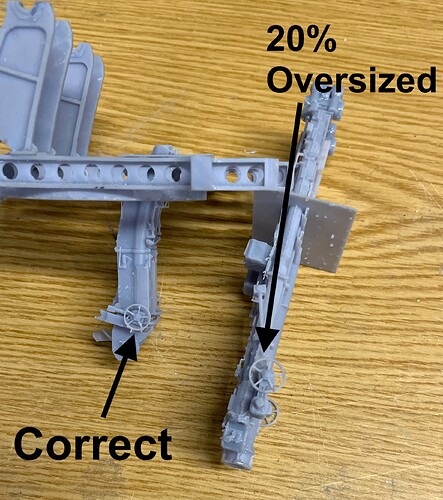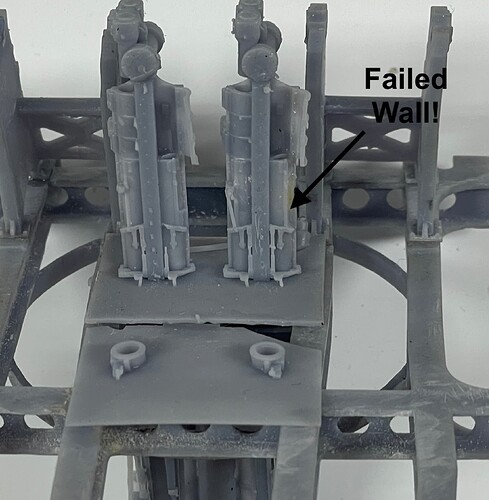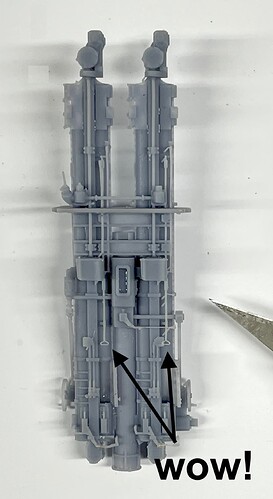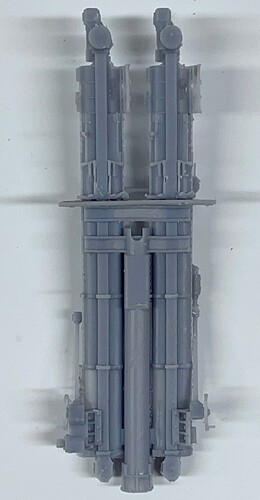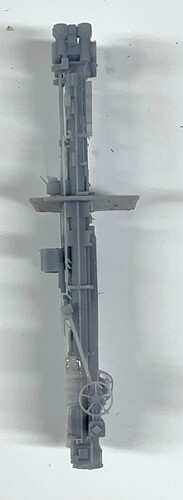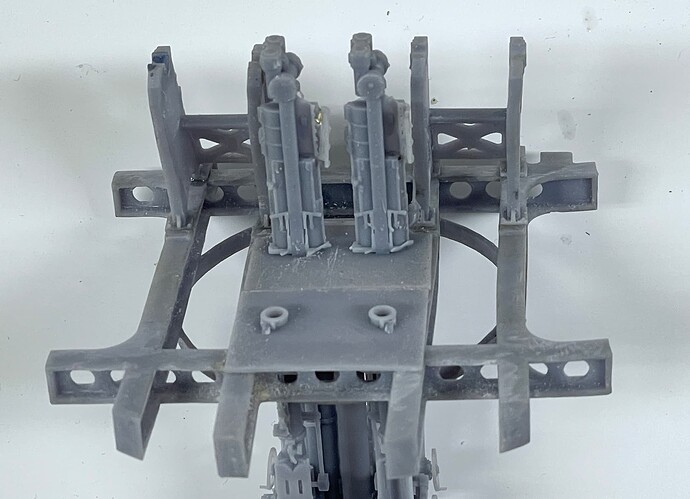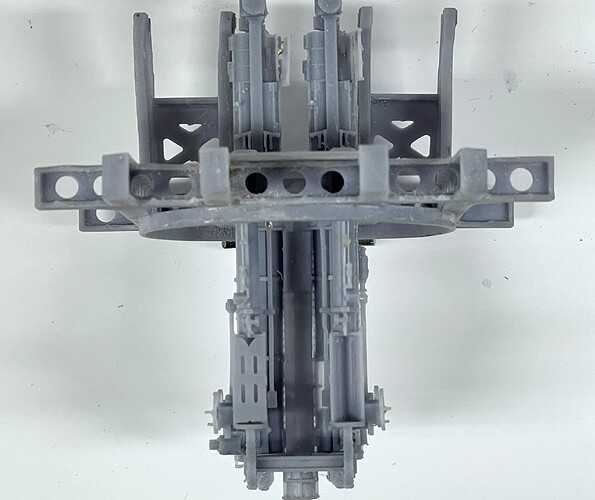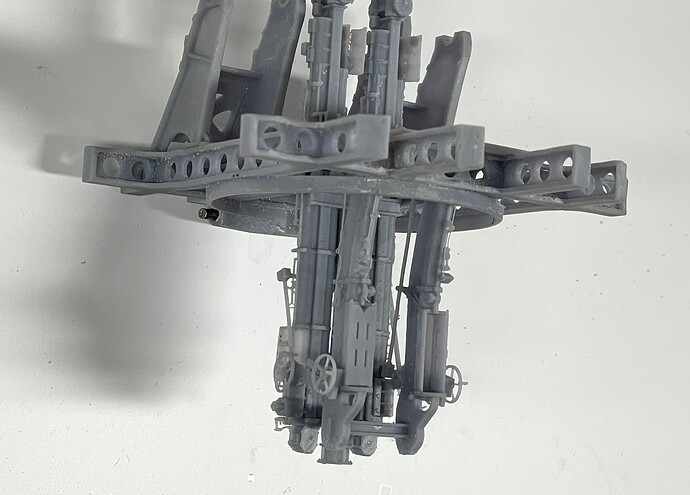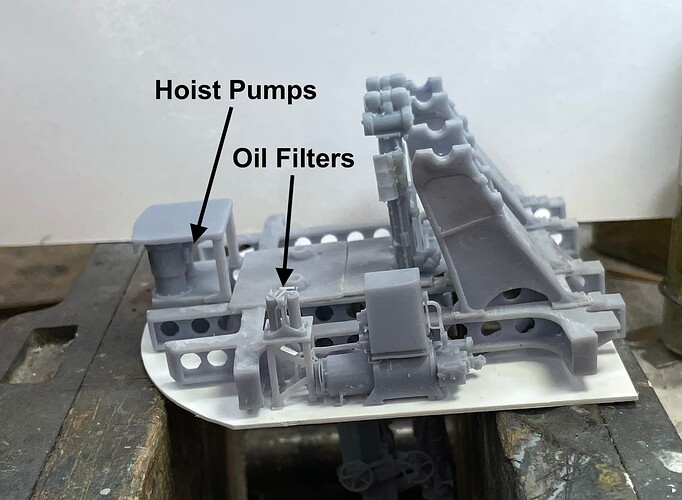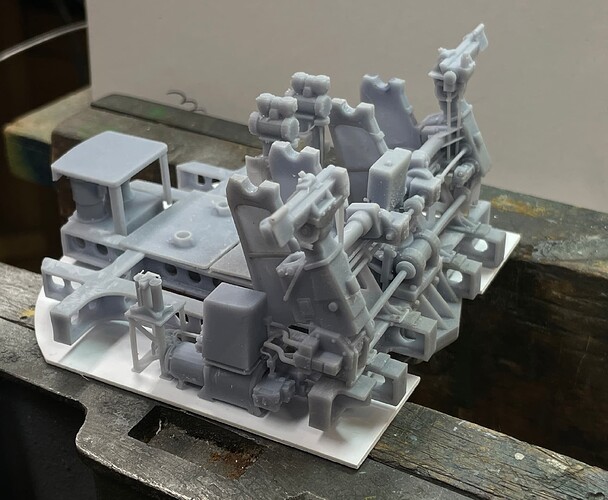Seeing the truly impressive results you’re achieving with this and your prior 16" gun turret project, I’m sorely tempted to dive in with 3D printing but I know as you’ve shown us here there’s a STEEP,STEEP learning curve to get where you are at this point.
Awesome work !
Thanks! It is certainly a steep curve since it’s a completely new area of study, with little or no connection to previous learning. it’s all novel. I’ve been at it now for over four years and still have failures that have me scratching my head… for a while. I’m at a point where I can sleuth out most of them pretty fast. But there’s a lot of help out there that wasn’t around in 2019.
I found out that the fuze setter regulator that I modeled last week was an older version that was NOT on the Iowas. At first I thought, “Who’s going to notice”, but then my AMS took over and I had to draw and print a correct one. Ryan appreciates this.
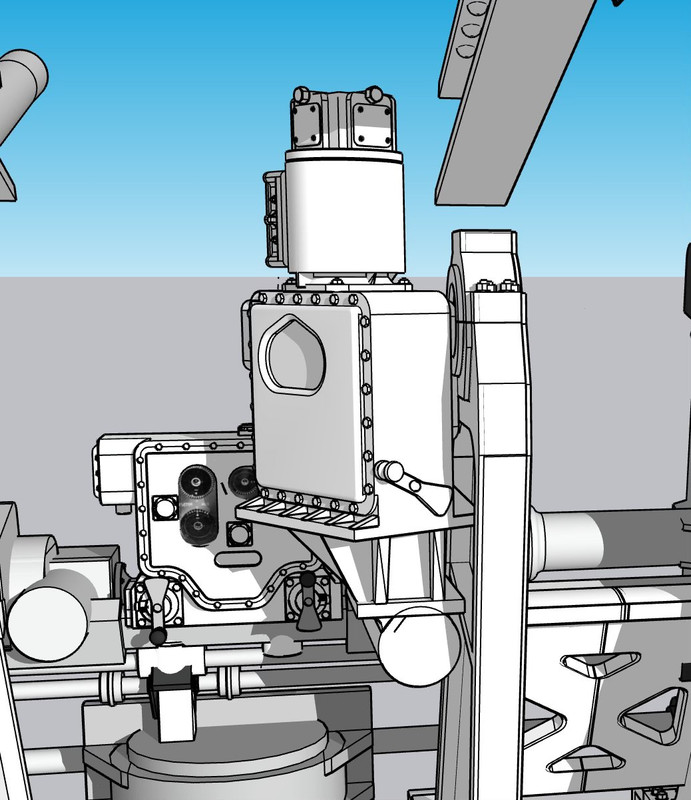
It printed nicely. I also printed the opposite hand versions of the optics shields so I can pick either open or closed on both sides of the gun shield. And I printed some scale 5" projectiles. I’m going to need a bunch of these since they’ll appear in the gun, the hoist the ready service room and the magazine.
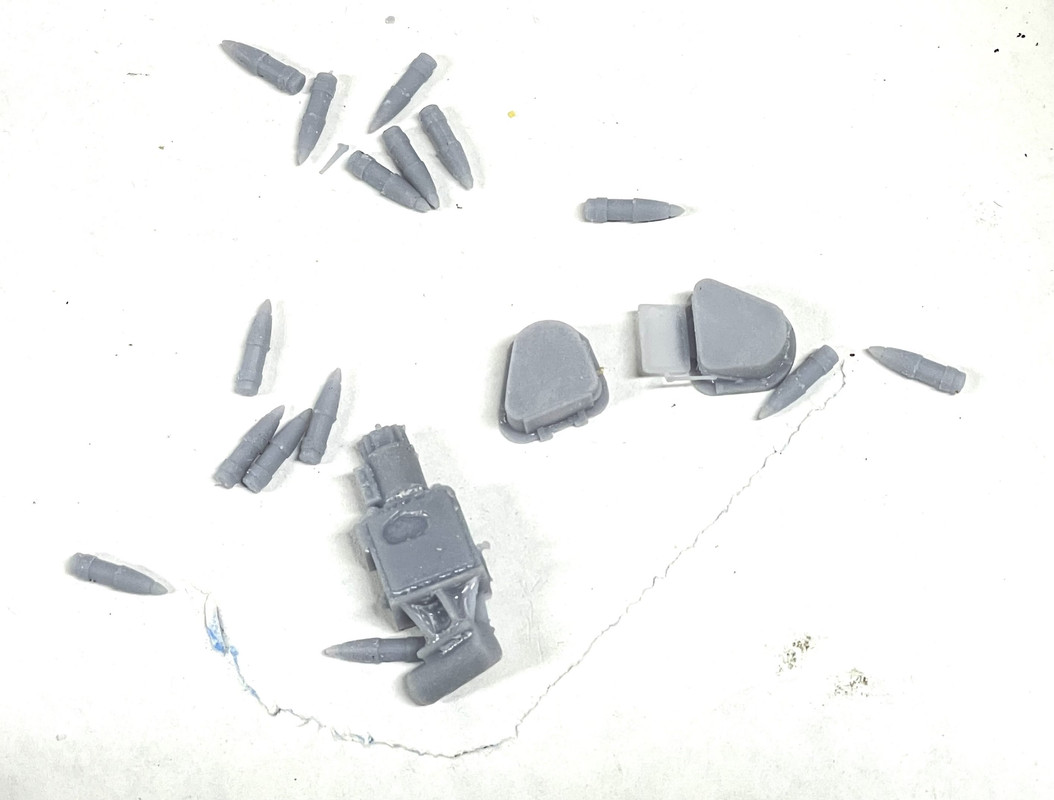
Then it was full-steam ahead on the projectile and powder hoists. As complicated and confusing the sighting mechanisms were, this one is more so. Not only are they complicated beasts, but every illustration I have shows me something different. I sometime don’t know if I’m looking at the same mod number. I know there are slight differences between the mount versions in lots of ways and these could differ as well. It’s even confusing determining where the central tubular column sits. Is it in between the two projectile hoists, slightly behind them or equally located in the center between the projectile and powder hoists? I’ve asked Ryan to cast the deciding vote.
Even so, I’m a couple of days away from finalizing the projectile hoist part and will move on to the powder hoists. Regardless how the center column is situated, it appears that it provides support to all four hoists. In additon to getting the details and relationships nailed down, I constantly have to keep in mind how it’s going to print and finally how am I going to get it all together. I found some actual diamond plate in the SketchUp 3D Warehouse that the artist has actually drawn the pattern in 3D so it can be printed. I’m going to attempt to print the hoists with the flooring in place in a single piece. I want to do it this way to ensure that it is all perfectly aligned. I test the part periodically in the slicer to make sure that it’s all solid and will fit the printer as it gets bigger. I pay special attention to all those rods and connectors to make sure they’re supported in various places (even if it dosen’t conform perfectly to the prototype) and they’re all perfectly contected to all the points and surfaces they’re supposed to be.
Here’s what it looks like now.
First, a screen print off of SketchUp: The tiny thing you see in the red square is the exact same object 100X smaller. That’s actually real-world size. I’m drawing the object 100X enlarged to prevent any “small curve segments” that SU runs into. The entire drawing is saved as a component. Anything I add or modify on the big version duplicates instantly on the 1:1 version. I use the 1:1 version in the master drawing of the entire model, and it’s the one that’s exported to the scaled drawing where I reduce it again, by .021 to make it 1:48 scale for the printing and the actual model. By using it as a component I don’t have to copy and scale it every time I want to use the 1:1 drawing. it’s always there and up-to-date. It’s so tiny that it’s easy to lose it, so I put it on that big red square so I can easily find it.
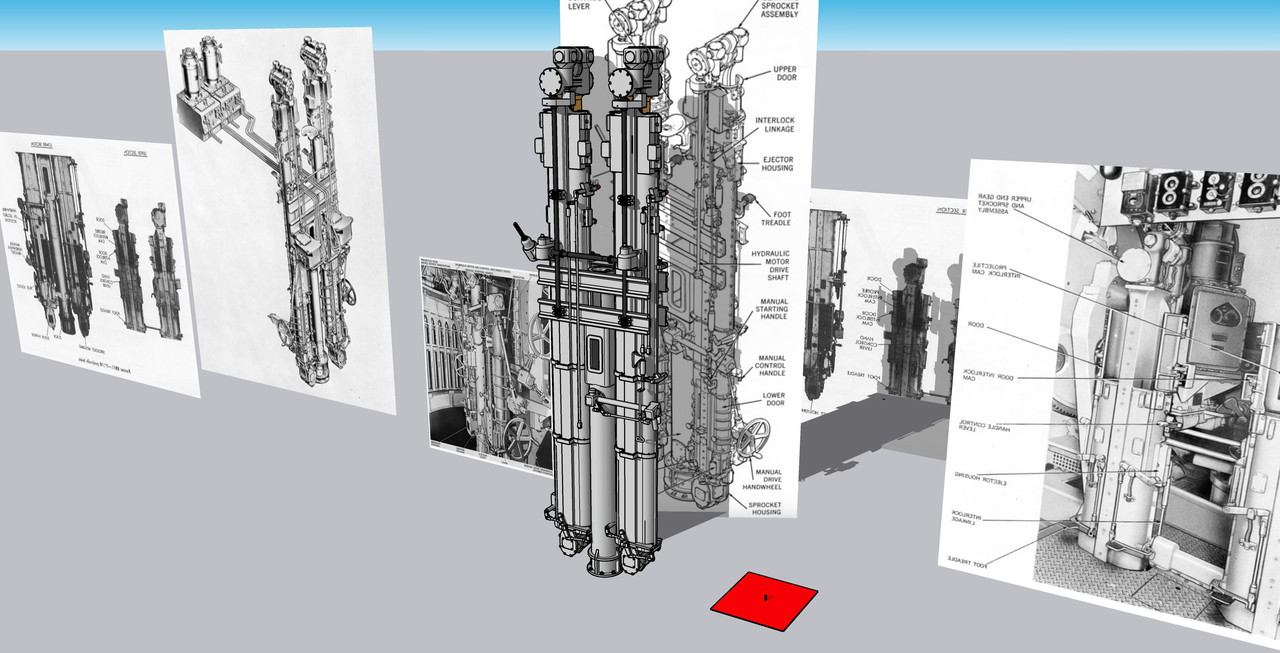
And the same drawing rendered in V-Ray:
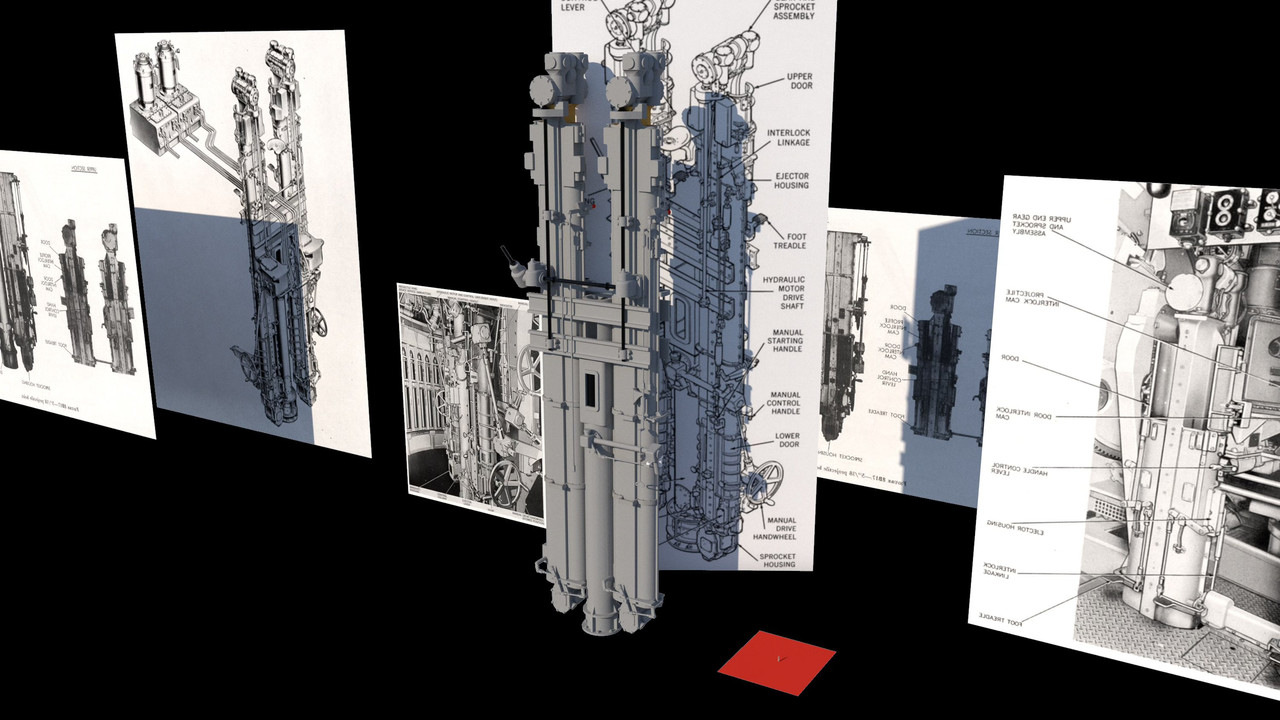
Still to do: The lower doors, and the power and hand-operation linkages. Part of the power system is drawn, but there’s still more to do. I’ve made the center column hollow and will use it as a wire chase duplicating its real world purpose.
It took over a week to draw the projectile hoist. It’s complex, ambiguous in parts, had penetrations and curve cuts that needed shape cutting, and finally, required some major rework to get it as right as I can.
The rework was this.

This central core had gotten so messed up with multiple diameters layered in on each other which created voids, reversed faces, and other anomalies that I couldn’t get a decent solid image on the slicer in my tests. I finally bit the bullet, stopped screwing around with it and redrew it from scratch. This time it was perfect. All the discontinuities that plagued me were now gone.
I also figured out the routing of the handwheel linkages. Speaking of handwheels, I wanted to make sure that they would print perfectly since they’re quite frail even when perfect. If there were joints that weren’t true, it wouldn’t hold up. That took a couple of hours.
And speaking of hours, it took an entire afternoon to get the lower doors right. Again, when I put them on the slicer surfaces were showing up as invisible. The “Solid Inspector 2” add-in kept showing surface interface irregularities. I went inside the object using the x-ray function and removed all non-functional surfaces and made sure all the face surfaces were perfectly tight. I was rewarded with beautiful objects in the slicer.
One of my other forums is SketchUp’s. I post this in its entirety in five forums. The readers in the SU forum are expert artists and offer good suggestions. One was to not scale the 1:1 object in a 1:48 file, but instead, just load the 1:1 object in the slicer and do the scaling right there saving a whole range of copy/paste operations. With this massive file, those take a lot of time. Another suggestion was to set a camera scene facing directly at the tiny 1:1 component so with a click of the track pad, the 1:1 is instantly brought into the center of view. Otherwise, I have to keep zooming in many times to get the object to fill the screen. These zooms take a lot of time with big files.
Here’s the finished object Front view:
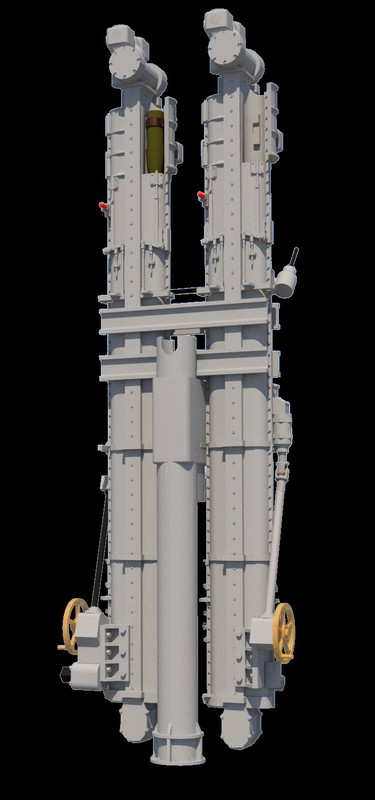
And the rear view:
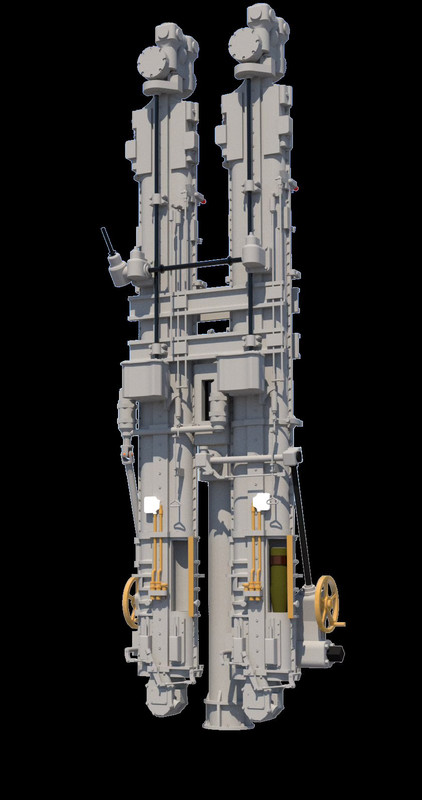
I’m going to attempt to print at least this part of the hoist system as a single part. Here’s the part sitting on the slicer. It seems perfect. Will all of the intricacies print… who can tell. I only know when it’s finished. That’s the fun of 3D printing.
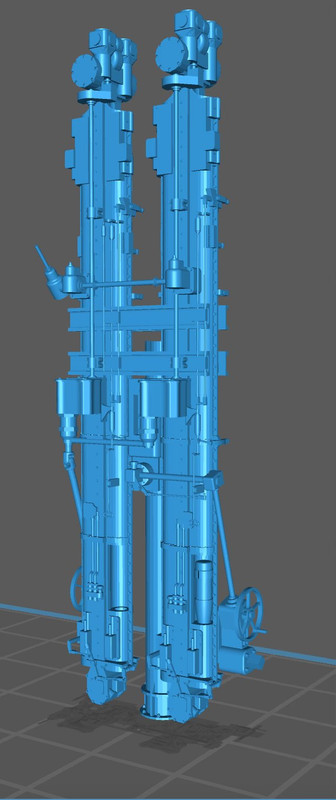
I can now work on the powder hoist part of the system. This should be easier since there is no fuze setting linkage, only a single channel per side, simpler doors, etc. There is one complication; the chute follows a curve and seems to change diameter.
Thanks!
While it took less time to design the powder hoist portion of this system, it still took 6 days to do it. It is singularly, the most complex SketchUp work I’ve ever done. This still conforms to my goal for each project I take to push the envelope further and keep increasing my skills. It had all the same ambiguous drawings as the projectile side, plus some more complex geometry, little links that had to be ferreted out as to their purpose and destination. And finally, I had to keep imagining how it was going to print and ensure that every surface and every little appendage was fully solid and attached properly to all the other parts so it would print with integrity. When it was all done, I did one final fit into the master turret drawing and found that the powder hoists were spaced about 2" on each side too wide. Luckily, moving them inwards didn’t create any new problems. They have to slip between the main frame rails. I could have trimmed the rails during assembly, but that seemed like cheating.
I incorporated that fully-modeled diamond-plate floor with the hoists to facilitate wrapping the plates around the protruding hoists and to add another piece of structure to keep their spacing.
This view shows the lower portion of the projectile hoist with their respective access doors. I modeled one open with projectile ready to go up to the gun house and the other closed. This is an accurated depiction since its upper doors are open with another projectile ready to be placed in the gun tray.
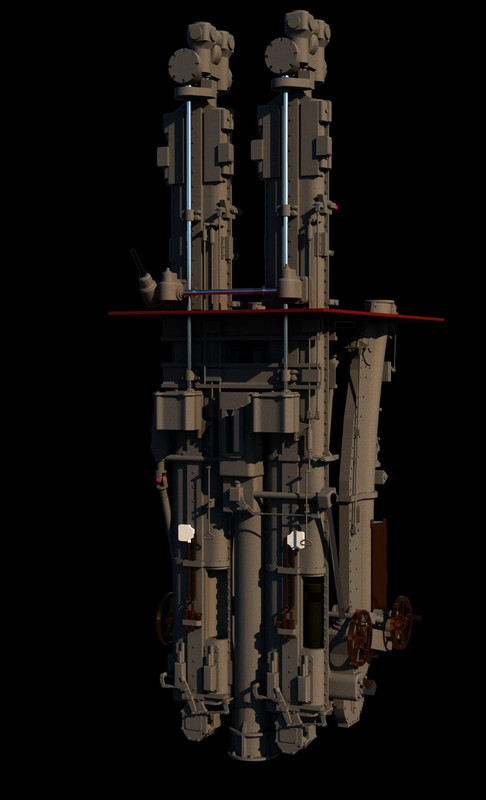
Those manual handwheels are going to be very delicate. If they don’t hold up when printing with the entire assembly, I’ll print some separately and add them later.
The reverse view shows the powder hoists and the little aspect that pokes through the floor. There is an operating foot pedal that’s also above the floor plates.
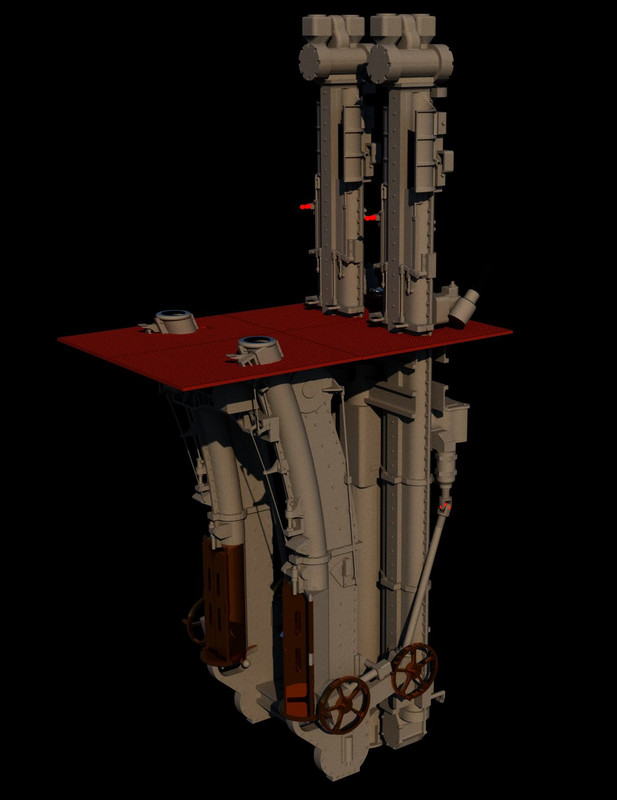
I learned how to find and edit materials in the V-Ray rendering engine that’s part of my new SketchUp installation. It’s more complex to operate then my previous add-on renderer, Podium. It’s also more sophisticated, faster (much faster) and does a much better rendering job.
I gave up on the idea of printing this beast in one piece. Instead I designed the two pieces so they will index together during assembly. I did this by adding some more structural steel at the bottom tying the two powder hoists to the central column. While this is not prototypical, I took artistic license to make the model work.
I also split the floor panels and added a lip to align and give purchase to the asembly joint.
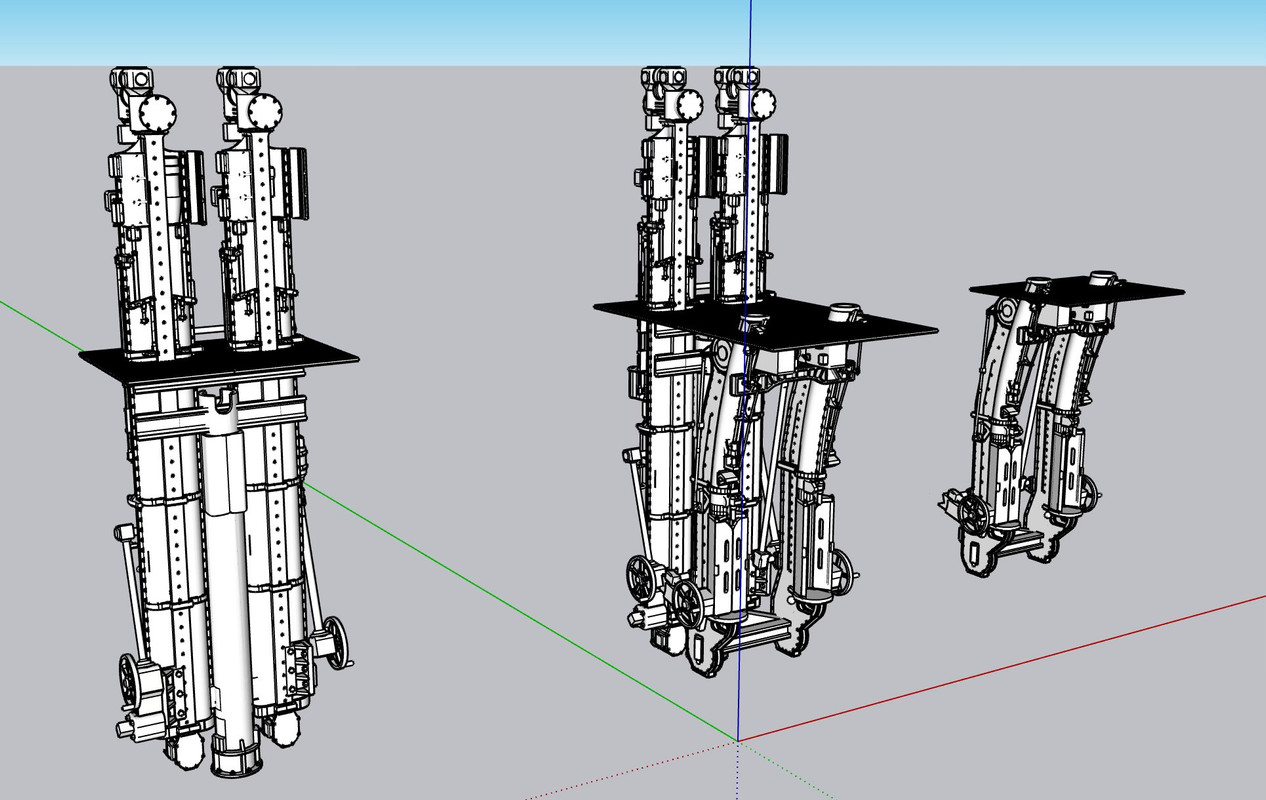
Here’s the mess of supports needed to set it up for printing.
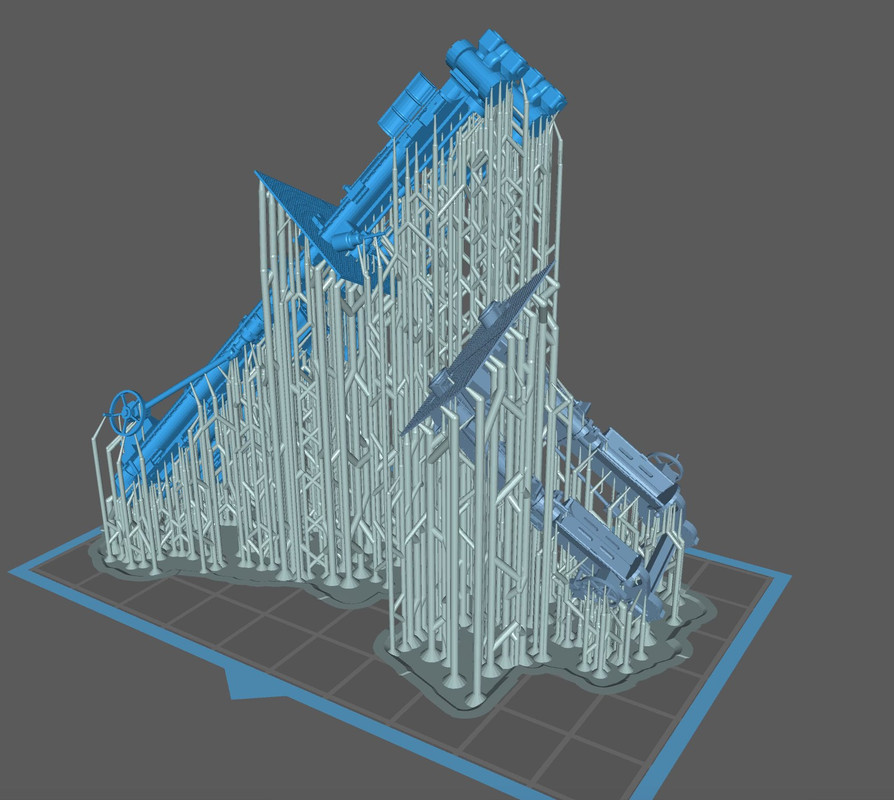
It’s on the printer now and will be done after 10pm. I’ll know then whether it’s successful or not. Then I’ll have to figure out how to remove all those supports without wrecking anything. Wish me luck.
This was the last of the really complicated parts on the project. The rest is downhill.
I was able to get good parts for the projectile hoist after three tries. The first, for some reason, came out 20% over-sized. Something occurred when I made the scaling in the slicer. I don’t think it was loading the wrong factor (2.08%), but rather was my entry. I may have double-clutched and got an erroneous value.
It was a shame. It was a pretty nice part.
The powder hoist portion was decent, but the control links were too fine being close to scale size. I doubled their thickness, and also increased the floor thickness by 2X to increase its stability and make the diamond plate texture more pronounced.
The 2nd projectile print, while correctly sized, needed a lot of repair. I broke one of my cardinal rules: Scale thickness doesn’t always translate well in the 3D printed 1:48 world. I made the columns prototypically hollow with the twin bores extending full length. The resulting wall thickness was so thin that it ruptured all over the place. It was actually translucent. I attempted to rebuild them with Bondic, and while structurally stronger, looked awful.
As with lots of SU projects, fixing is often more difficult than making it right the frist time. And this was no exception. Took about an hour to fill the bores. I also took the time to strengthen some other dubious connections. While doing this I also fixed a lot of drawing stuff like hidden layers that didn’t do anything.
I was rewwarded with a really nice print. I only had to go back and reattached some tiny links and further strengthen the door hinges.
Get a load of those very fine pull handles compared to that #11 blade. I was impressed. I also added some mid-run supports for the long-run link rods so they would have a better chance for printing and after-printing survival.
I had to notch the floor at the front corners to nestle over the gun mount’s rear feet. I was worried that after all this work I couldn’t install them, but if I moved the powder hoist as far aft as it would go, carefully inserting the projectile hoist sideways between the frame rails, I was able to lower it and twist it into position. I did have to relieve the width a bit at the cross-girders to make it a slip fit.
This was, without a doubt, the most complex parts I ever produced, and is the apex of complexity on this model. With it successfully done, I can breathe a bit easier.
I drew and printed the floor pans that sit between the frame rails under each gun. These are sheet metal affairs in the real deal, and have a curved floor that follows the arc of the gun. I made perfect prints. Perfect, but for the fact that they were about 5 scale inches too wide! I used the drawing of the frame rails for sizing assuming that my printed part was the same. For some reason, it is not. I will redraw and reprint. They weren’t the only thing that was too wide for the frames rails. The gun itself was too wide to drop down between the rails. More about this later.
The oil filters and pedestal were easy to draw and print. I drew the tiny hand screws on their caps, not knowing if they’d survive printing and support removal, They did!
There is more text and three more images that should appear after this sentence, but the pictures were not transferring. I’m going to make another entry and see if I can get it to work. They were showing up in the preview window, but not in the posted thread.
Well… it seem sthat this worked.
I added more stuff and took this image. Starting to get interesting!
About the guns…
I was unhappy with the prints that I had. The entire trough didn’t print well, and the drawings were a mess with lots of hidden layers and voids that lead to print troubles. With the new print settings I was confident that I could do better. The wrong width gave me an excuse to attack it. Like before, making changes can often be more difficult than starting new, but in this case I did sort of a hybrid attempt using some old and some new. Spent all of yesterday afternoon and more time today to get the internal and external geometry right. I have a lot of time to draw as my wife is recuperating from major breast surgery. She had breast cancer 16 years ago, and it came back. The best of bad news is that it appears to be self-contained. She had full diagnostic scans that were all negative and the surgery went well. So we’re very optmistic.
I’m having a lot of SU crashes. Sometimes it occurs when doing tricky things like using BoolTools2 on big complex interfaces, but others occure just when I’ve made a couple on moves. I never lose too much work since I’m doing auto-backups every minute. But it’s annoying!
For some reason, connecting the straight side walls to that compound curved rear panel drove me nuts. I know how to do it, by intersecting the flat into the curves and removing the intersected parts, but it was a lot harder to do than it should have been. The assembly was built from a bunch of geometries that would cause surfaces to disappear unannounced if I erased the wrong line.
This geometry was the worse part. I’m very happy with how the curved trough is now designed and it should print perfectly. I still have a lot of stuff to add on, but I’m not worried about that.
Wishing your wife a full recovery most of all. The complexity of this project boggles my mind, you’re producing superb prints even though it’s fighting you every step of the way. I can’t help wondering how easy or hard painting will be – presumably hand-brush for all the intricate parts…that being most of them ![]()
Best wishes to your wife and hoping for a fast and permanent recovery!
And the model is sublime.
I also wish your wife al the best of luck on her recovery!
Hopefully she has a quick and full recovery.
Wishing your wife a speedy recovery and hope you and your family will keep well .
Always enjoy your posts and projects Myles.
Thank you fellows for you kind thoughts. She’s coming along nicely considering the emotional and physical impact this surgery has. It’s good that she has a partner who’s in good enough health to meet her needs.
Actually, when the painting begins I will be very happy. I really like the detail painting and the high resolution I’m now getting faciliates this aspect of the project. The gun house work is almost done. I have to make the sight checkers telescope and mount and some more floor pans and platforms and it’s ready to start building it. I need some more data on the ready service room floor plan. I don’t know what wall has the circuit boxes, the ammo racks, and the location of the upper end of the transfer hoists for powder and projectiles. I also don’t know which wall has the hatch. Ryan and I commmunicate regularly and I’m sure he’ll get me what I need.
With the amazing resolution the printer is finally giving me, I decided to redraw the main gun carriages and re-print. I was very unhappy with the malformed loading trough, the broken piping that I had to replace with metal, and the broken and mishapen controls. It took a couple of attempts (as usual) to get a really good print. I’m getting pretty good at predicting when and how big supports need to go, but I still miss a few. I did that in this case. So I did one print in the afternoon and then another repaired drawing version overnight.
Here’s a comparison of the early one done months ago (before the printer adjustment) and the new ones.
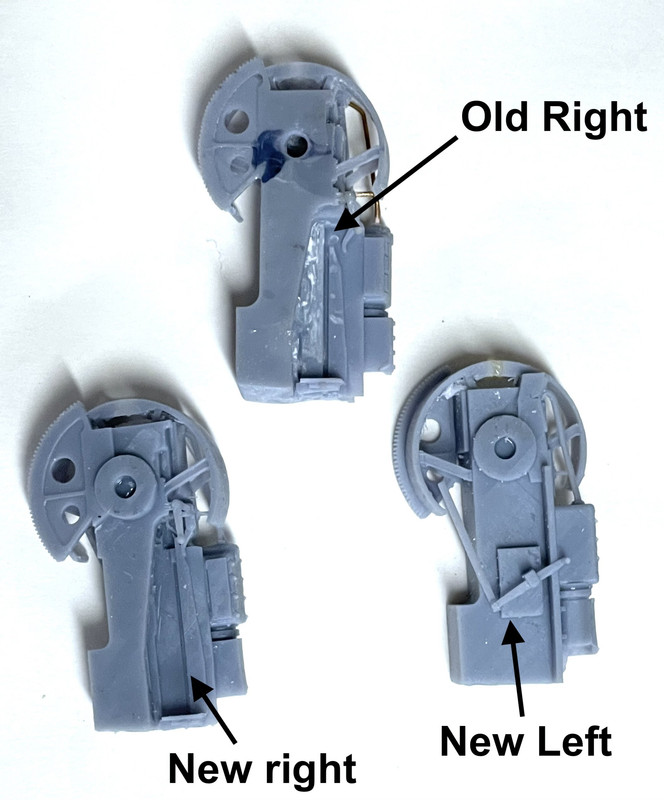
Here are looks down the part showing the that critical loading trough. Note: I have not done final finishing on these parts. The nubs you see will be gone before printing. I’m making one gun with the breach open and the other closed. I don’t think you’ll be able to see them in the finished model.
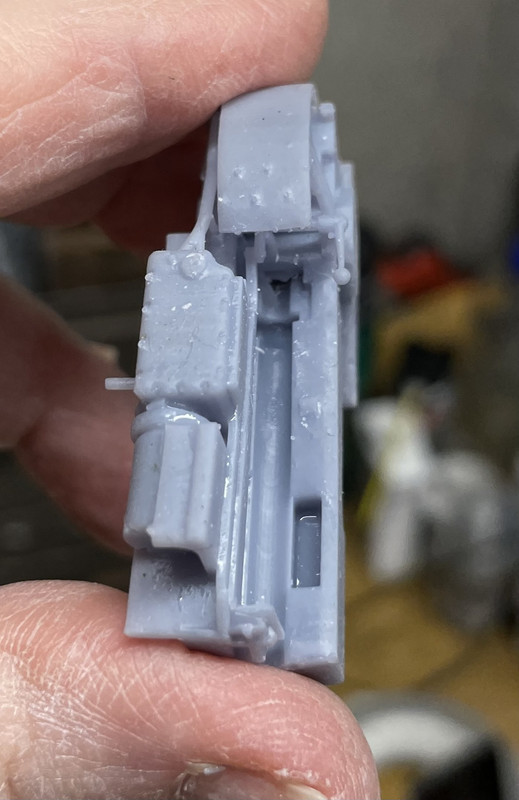
and the old one. In the first iteration the trough was filled with errantly formed resin. I attempted to grind it out and restore the concave apperance. It was barely acceptable. Notice also that I had to reattach the operating lever on the left and reform the ball end out of Bondic. The new ones have perfectly formed levers.

I also redrew and print the floor trough with the curved space for the gun elevation so it would fit acccuately in the between-frame space.
The gun house work is almost complete. I have to do some more work on floors and platforms, and build the sight checkers telescope and mount. I can then start painting and assembling it. I need more info on the ready service room that lies below. I don’t know the floor plan and need direction on what walls get the ammo racks, the circuit boxes, and the access hatch. I also need to know exactly where the upper ends of the powder and projectile hoists lie in the actual space. I had pictures Ryan took of these things, but didn’t specify just how they’re laid out.
With the new exposure setting on my printer, the supports are much stronger (as well as other tiny details) so on these complex parts, my routine is use the “auto-supports” feature with light supports on the entire part. I then go back and selectively delete light supports in places that would experience higher lifting forces and replace them with Heavy supports. In the past I couldn’t trust the light supports. They would break prematurely. With the 3.1 second exposure, they are quite strong and do not break. This really improves both the print success and facilitates cleanup. Most of them can simply be pulled off. I cut them carefully when they’re attached to delicate aspects such as levers and handwheels.
Some eye candy showing where the project is right now.
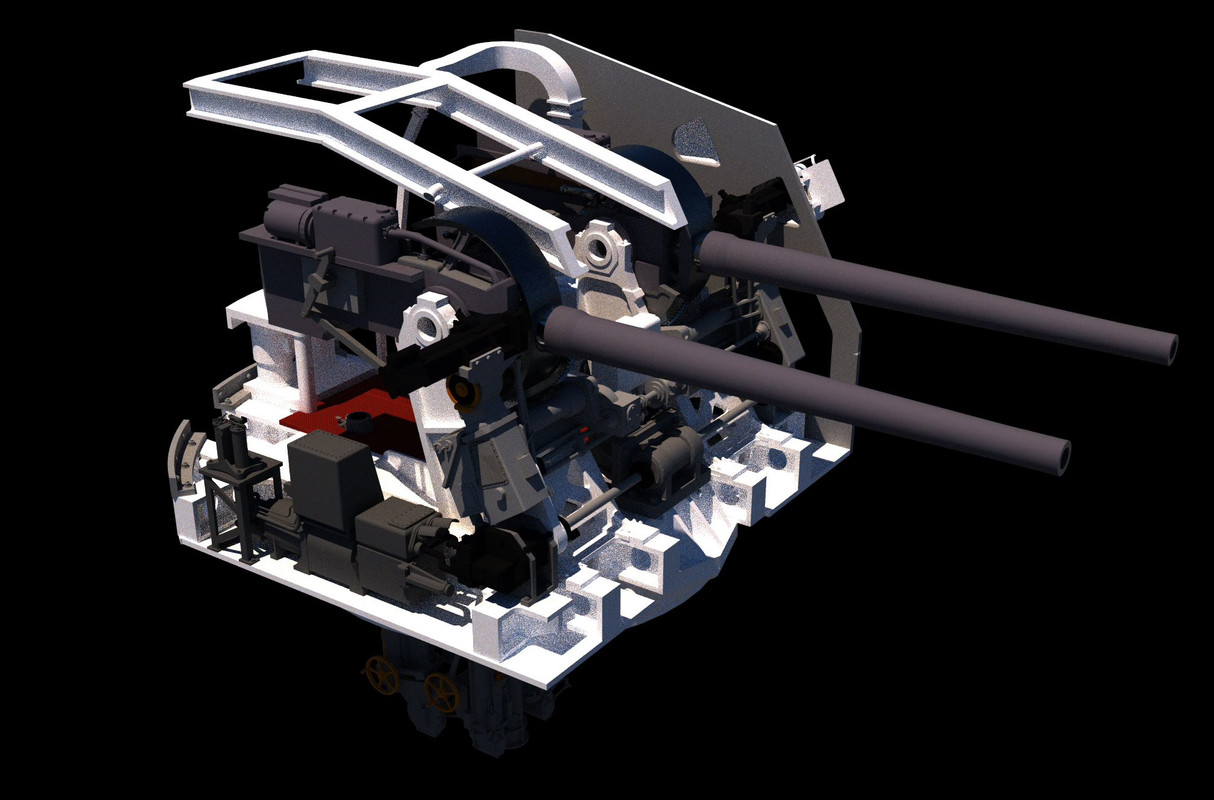
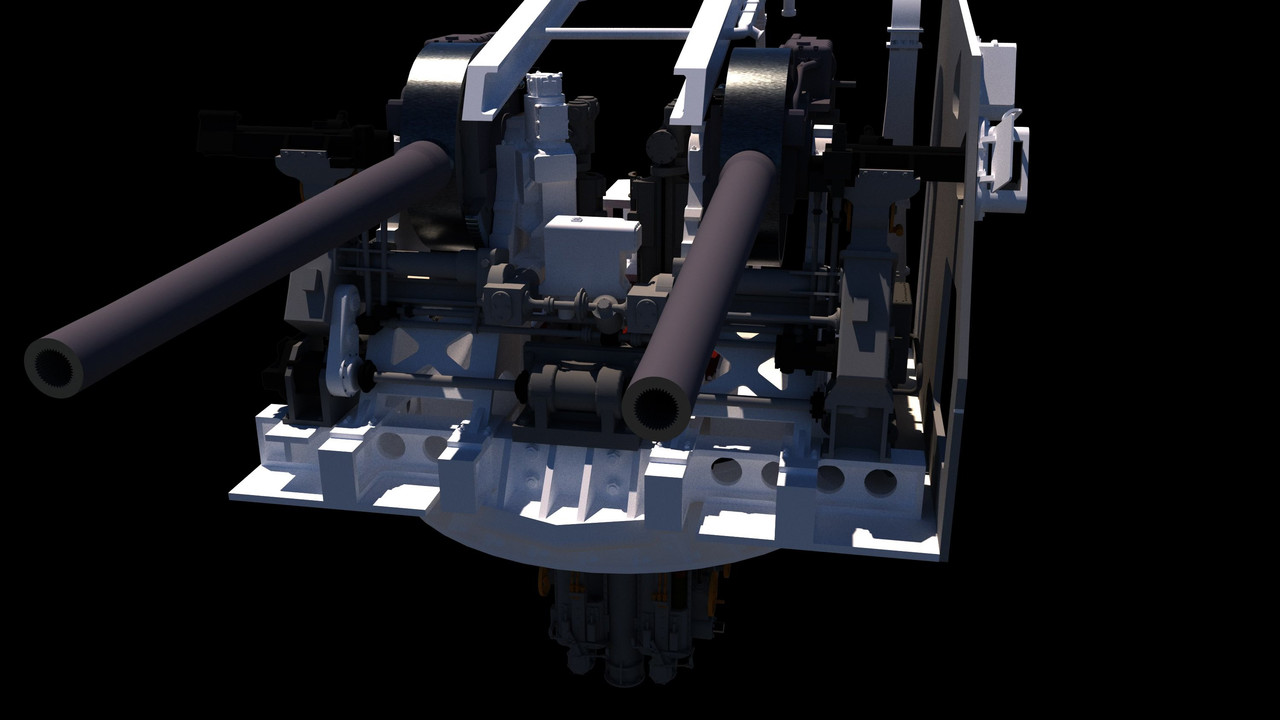
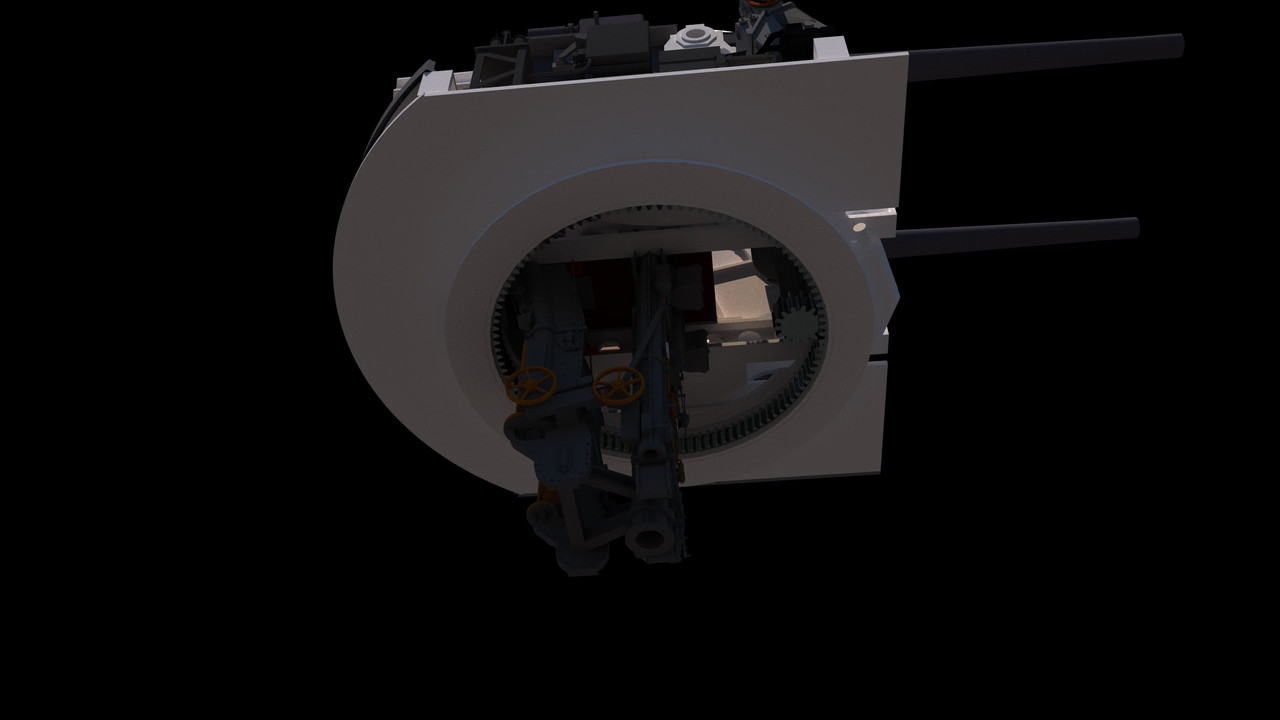
I got good drawings from Ryan showing accurate floor plans for the Upper Handling Room and the Magazine. With this I can finish the design phase.
Also, received good news from my wife’s pathology report from her double mastectomy. We are relieved.
Glad to hear things are looking up for you and Mrs .
Best of the season to all .
Cheers- Richard
Great news on her report! ![]()
![]()
Thank you very much. We both appreciate the thoughts!
Things are quiet on the homefront. Due to the nature of my wife’s cancer, even though the pathology was clear, will undergo a short cycle of Chemotherapy. All of this will be over in mid-March and we’ll be happy when it’s done.
During her recovery I didn’t work in the shop much, but I did a ton of drawing and got a lot of printing done. This is an example of one load with lots of odds and ends for gun house details. This pile includes shaped junction pieces to help me glue the roof plates at the correct angles and those really neat “tractor seats” for the trainer and pointer positions. I had found a bar stool with the correctly shaped seat on the SketchUp 3D Warehouse and then modified it to print and conform to the ship’s seat size and shape.
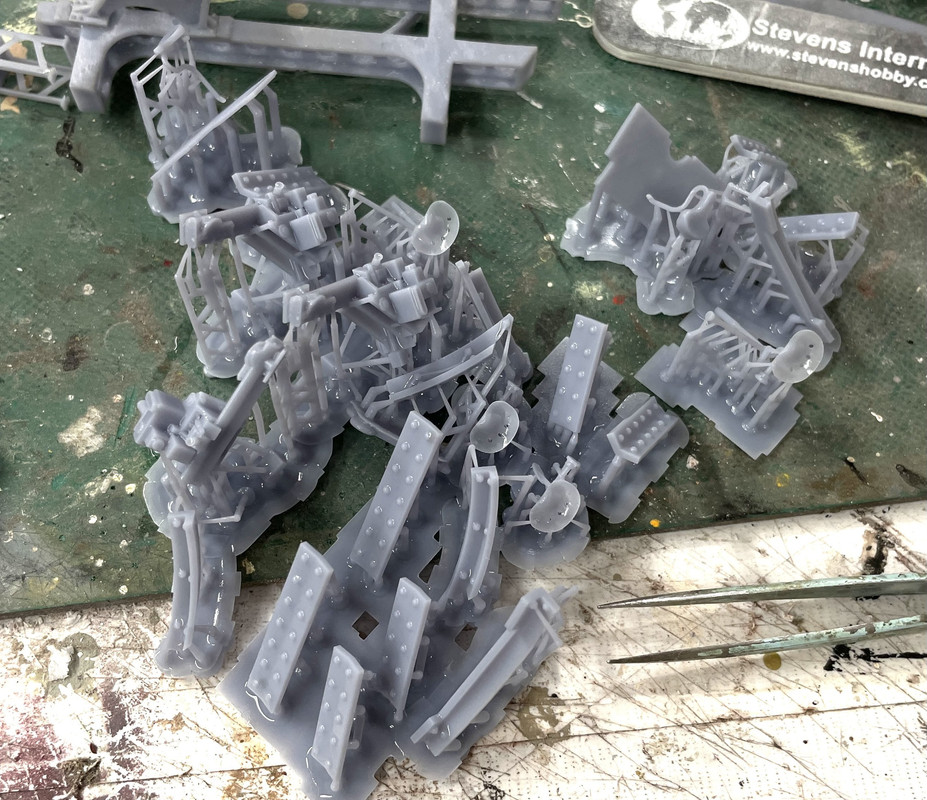
Here’s a closer look at the seats. There’s one more that’s printing now. It’s the bicycle-shaped seat for the sight setter position. It’s in the pile above, but, the bottom mounting flange was a separately grouped drawing that I neglected to combine with the overall model. When I conveted to the STL and then the printer, that flange wasn’t there so the seat pole was just dangling in open space.
This is the pointer seat:
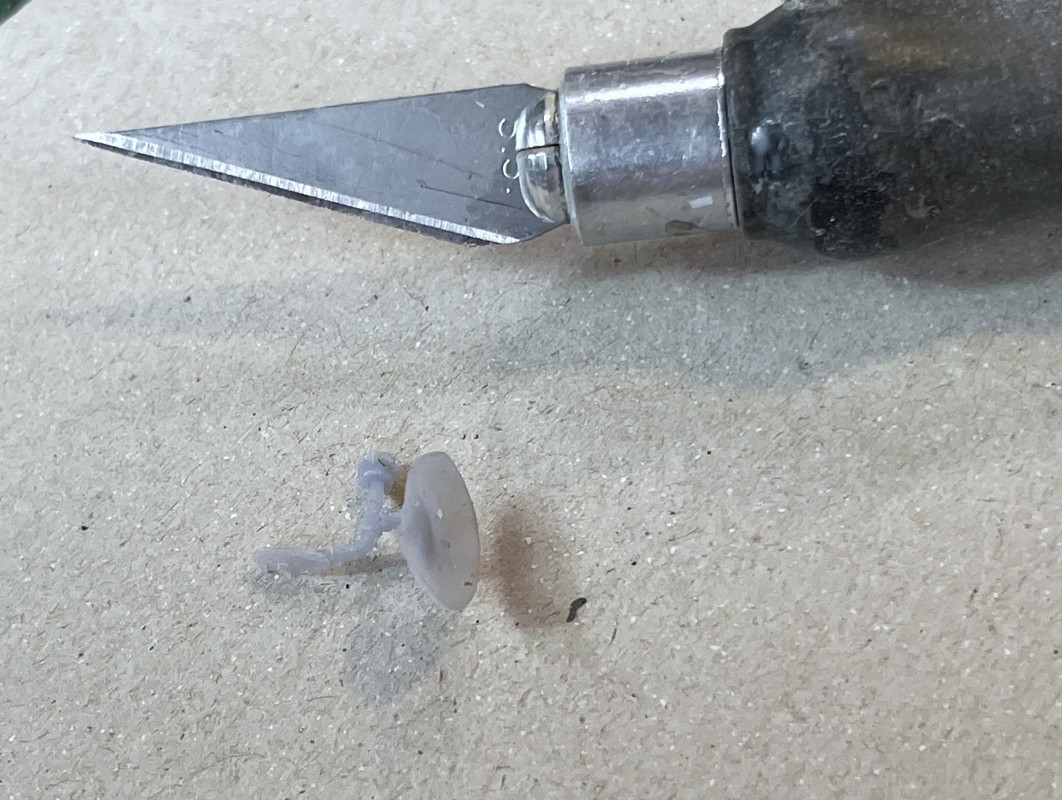
And this is trainer seat. Both are REALLY delicate, but well cured and formed.

The assembly process has officially begun. I glued the gun house base plate to the underframe. Styrene to UV rensin? Only with CA or epoxy. UV resin is impervious to most common plastic solvent.
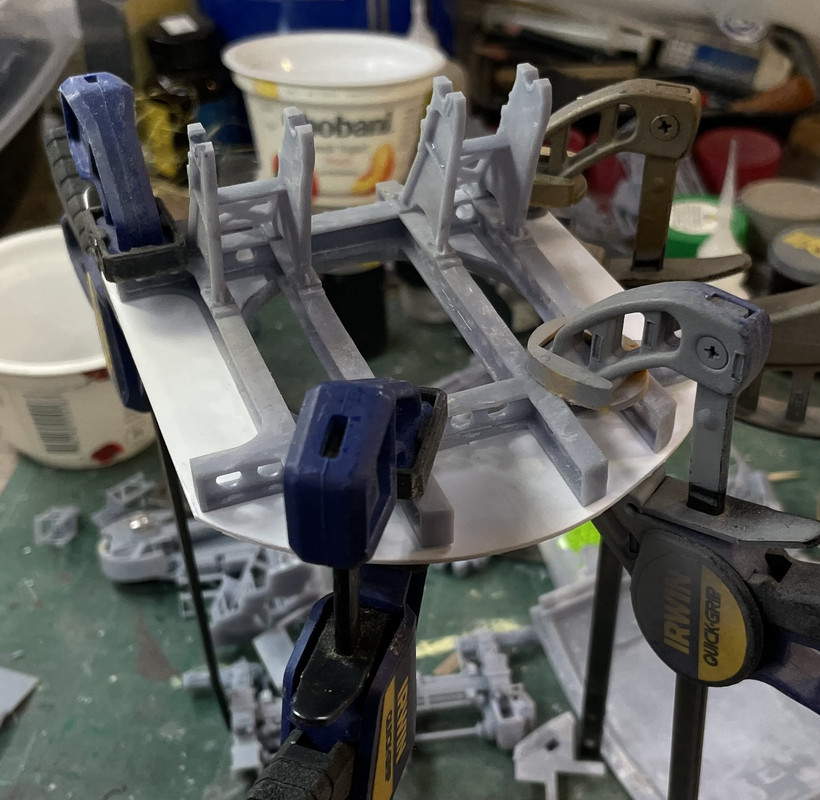
The print package was the flooring pieces. Ryan sent me photos of all the floor plates in the gun house and I was able to reproduce them with reasonable fidelity. I was struggling with the diamond plate. I had downloaded a piece of this from the 3D Warehouse. The artist didn’t group the pattern separate from the substrate so when I attempted to trim or enlarge the sample to fit my various piece shapes, I had to deal with the substrate disappearing, reversing faces, or just being a pain in the butt. Finally, I decided to separate the diamond patterns and group them. This allowed me to shape the substrate, which is quite easy, and then drop the diamonds onto the surface. Since they are their own group, I was able to erase them in one tenth the time it was taking before.
I designed he little box steps at the rear hatch openings to assemble with the curved angle brackets.
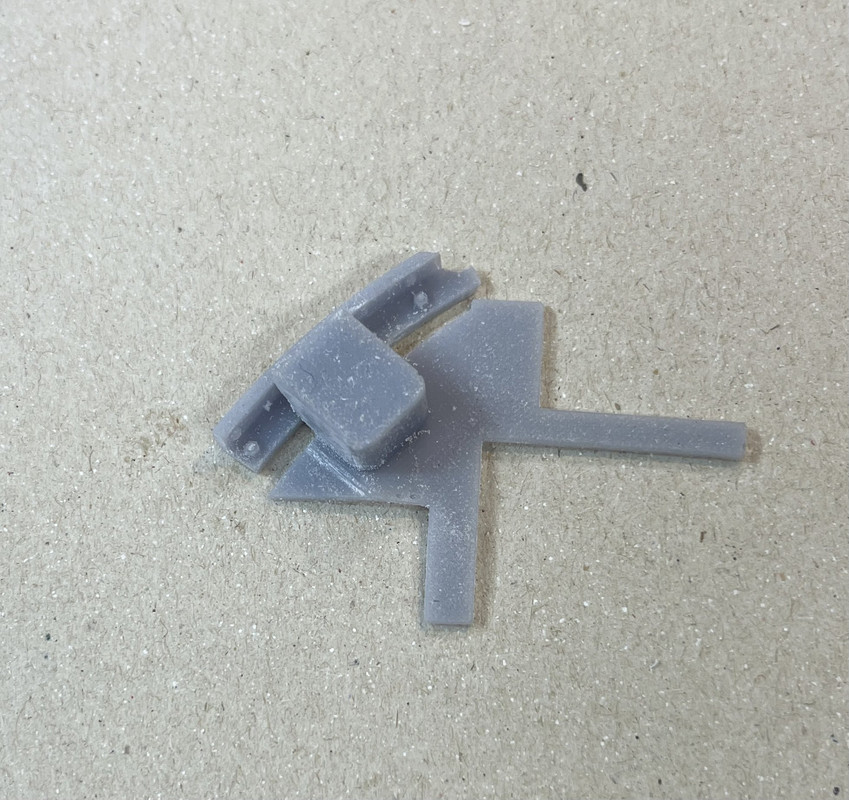
Here’s where they fit nesltled into the rear curved wall.
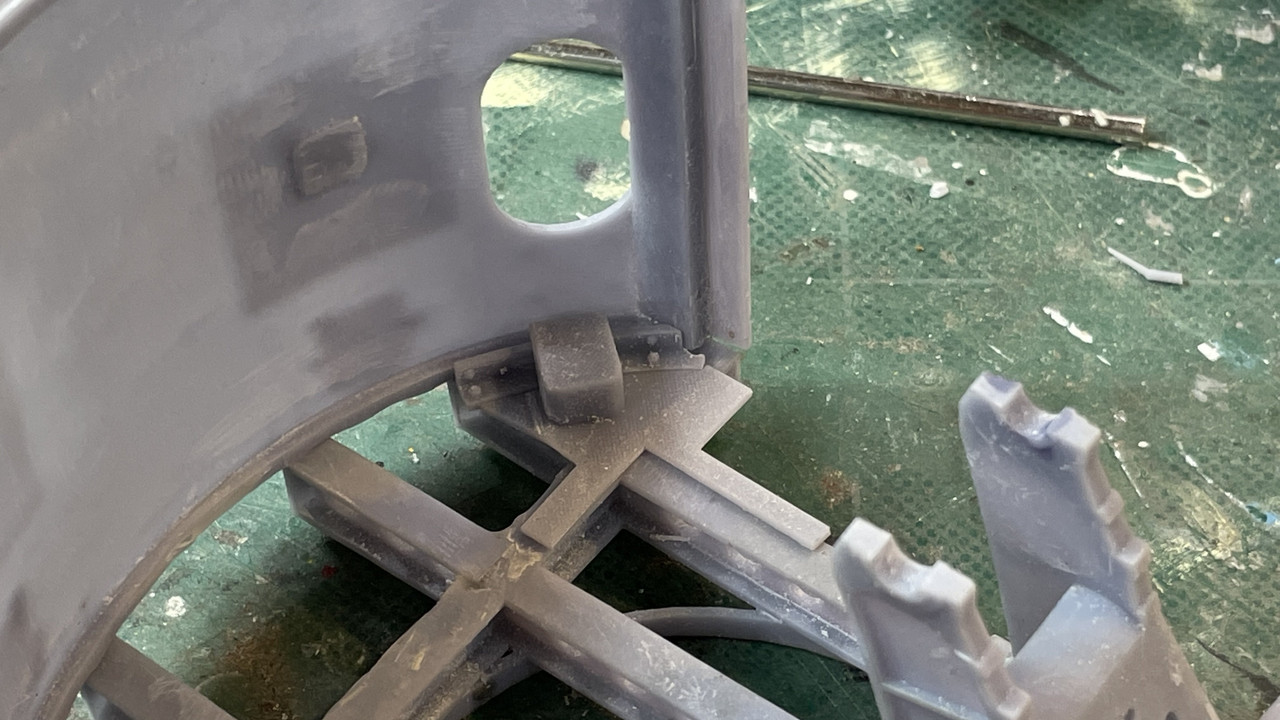
I assembled the floor pieces on the frame for fit and understnading the assembly process.
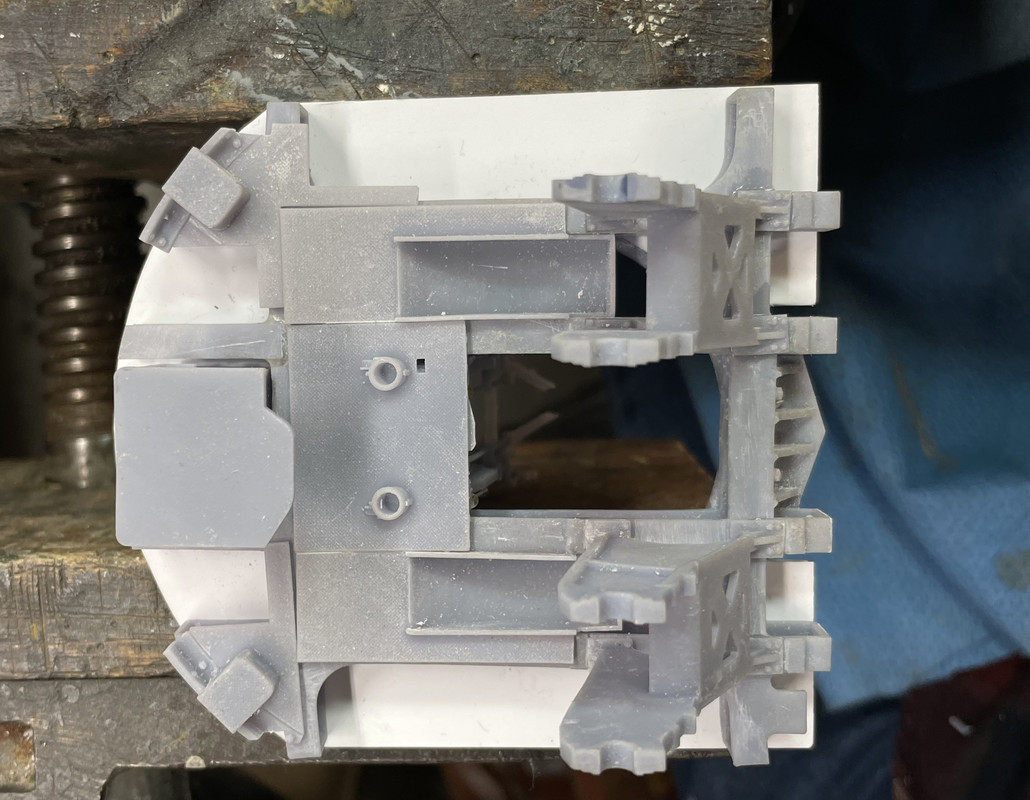
With the base plate in I’m able to test fit and locate all the gun house details starting with the elevation and training pump systems. The training pump was easy since it just has to nestle up against the piping I printed that come out of the b-end hydraulic motor. I marked the base, but when this is painted, those will disappear so I’ll probably go back and make some punch marks.
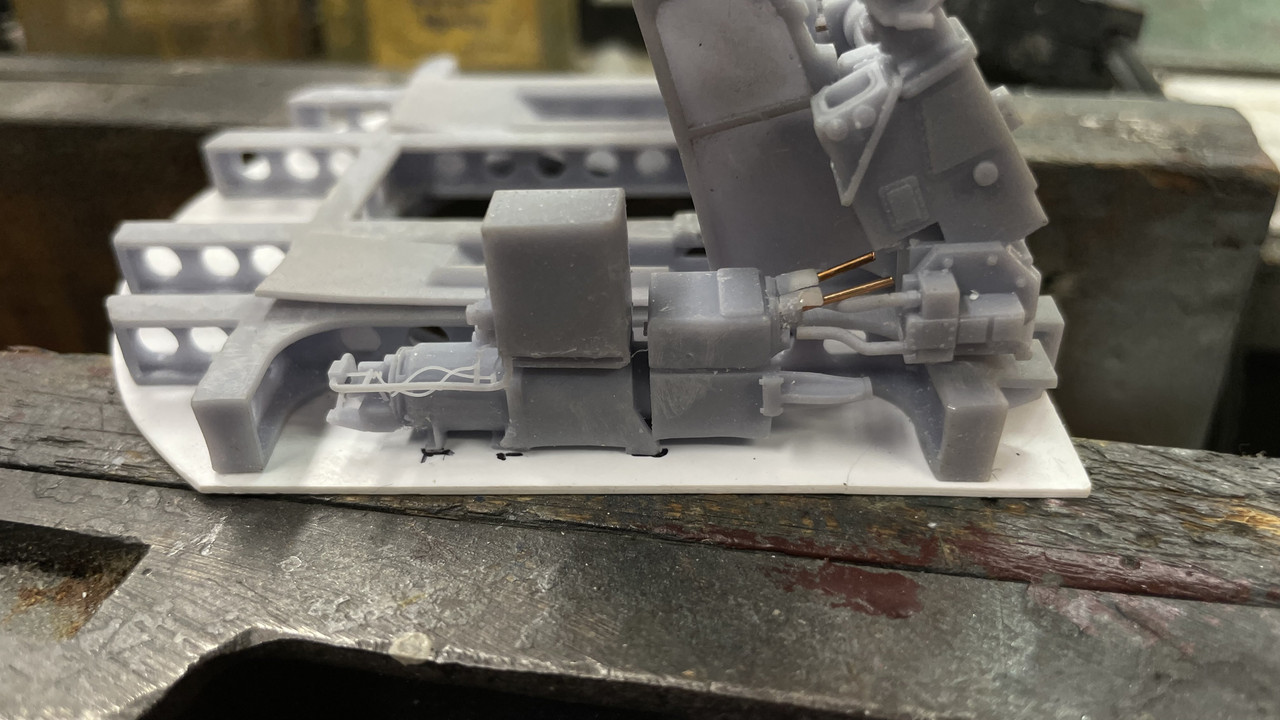
I then test fit the small, diamond-plated flooring pieces.
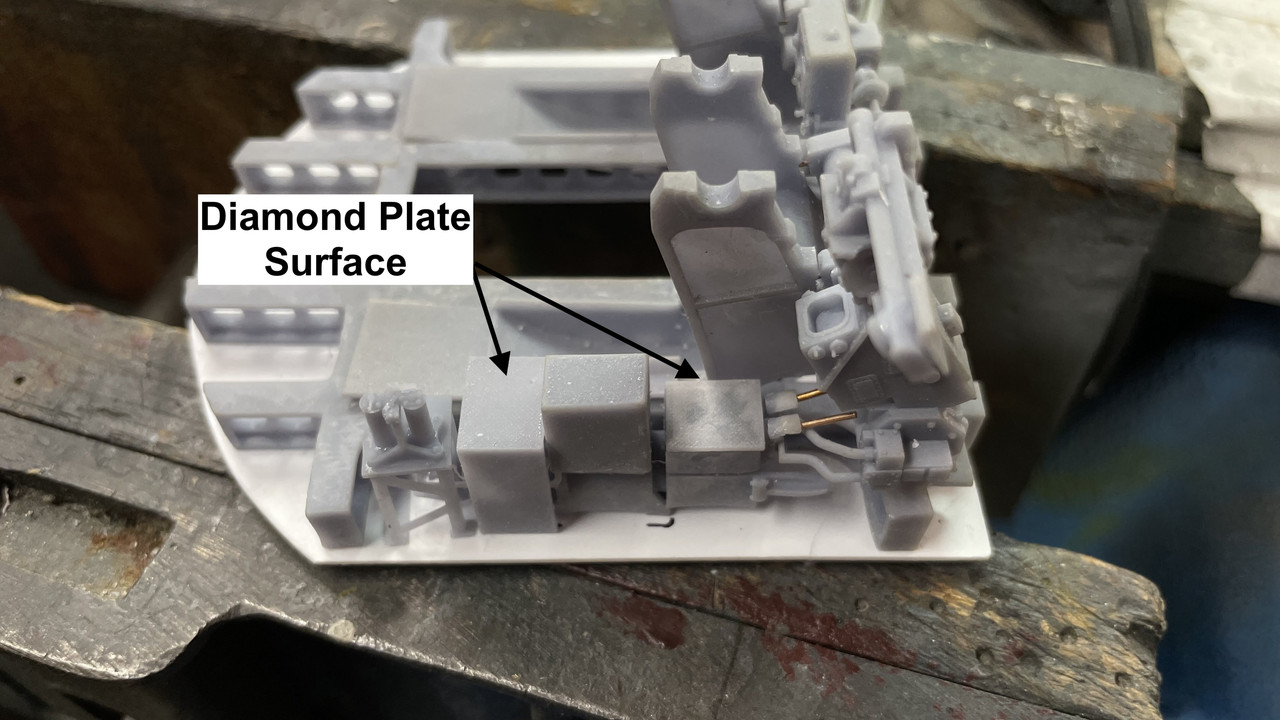
I did the same for the pointer’s side. This was a bit more complicated since the spacing is fixed by the very small floor piece that spans between the pointer regulator, where it sits on a built-in ledge, and the a-end of the pump system. I had to add a small piece of angle to support the aft end of the floor.
The angle:
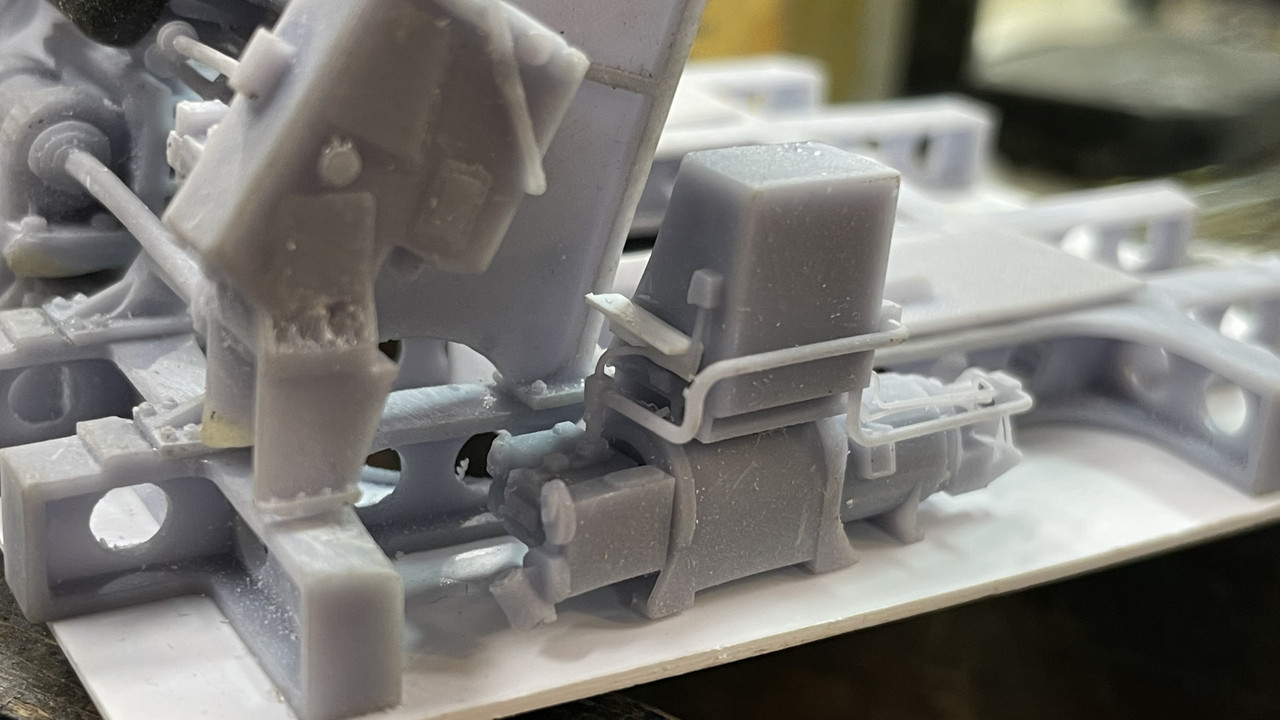
And the floor piece. It was very hard to see just how this little bit of floor was attached in the real thing. Ryan’s photos only show it from above and all the drawings don’t detail it sufficiently. I had to fake it.
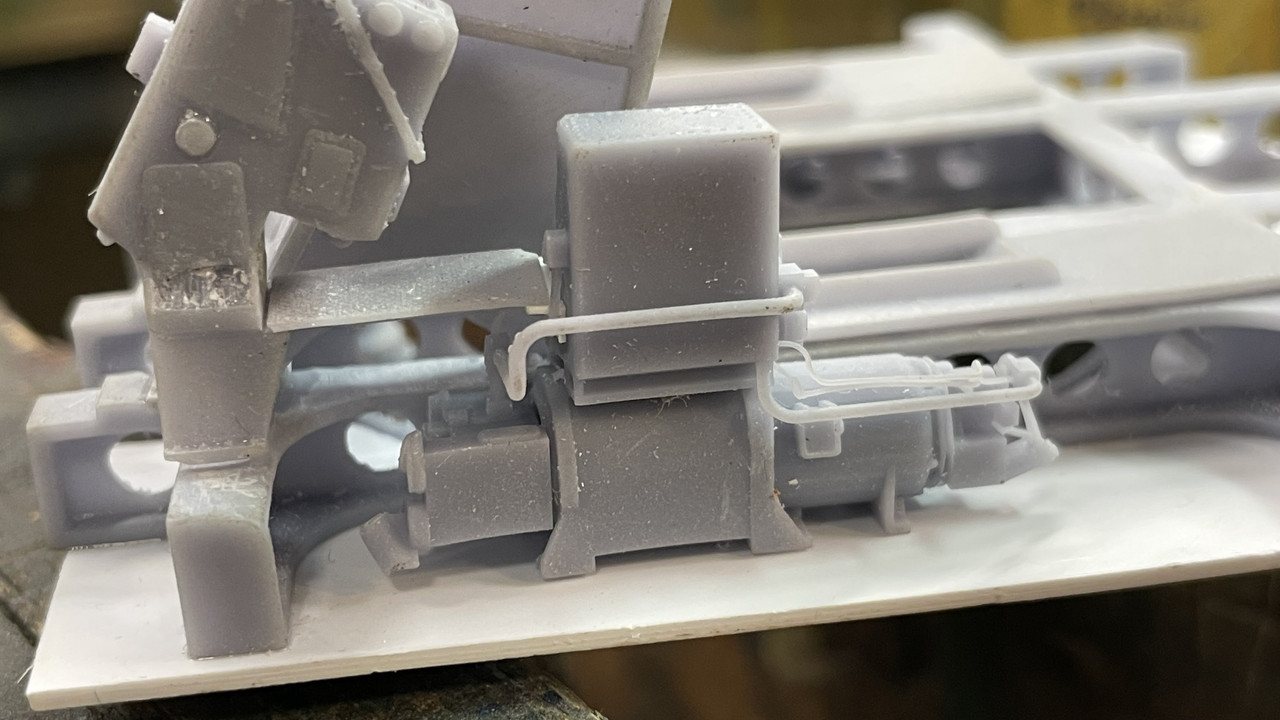
There are hydraulic lines eminating from the a-end of the pump which I will probably add old-school with solder wire.
The entire mechanism assembly needed some possible positioning on the gun mounts. i chose to use 0.022" phos-bronze wire. I broke way too many carbide drills doing this.
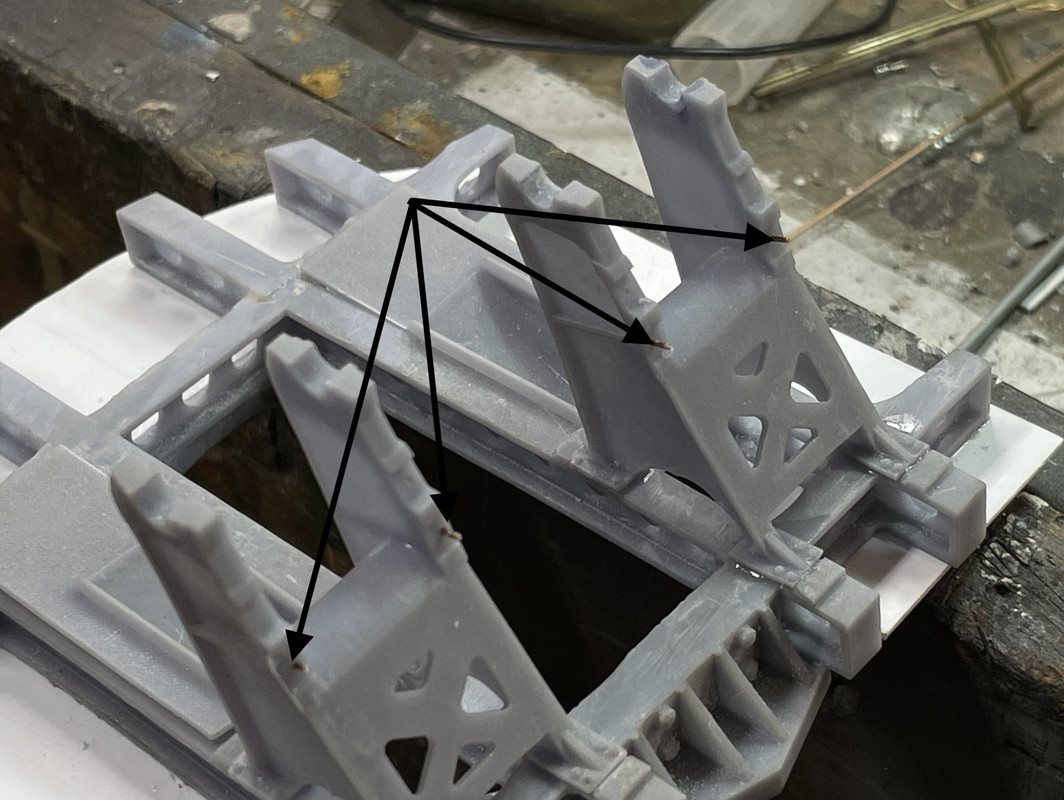
It took some trial and error to get the pin holes in the two pieces so they’d line up. I then drilled and pinned the mounting for the fuze setting regulator. This simple job almost went completely south. I kept breaking the 0.03 2" drills doing this simple operation. I ended up having to drill three diffferent holes to get one without a piece of broken carbide in it.
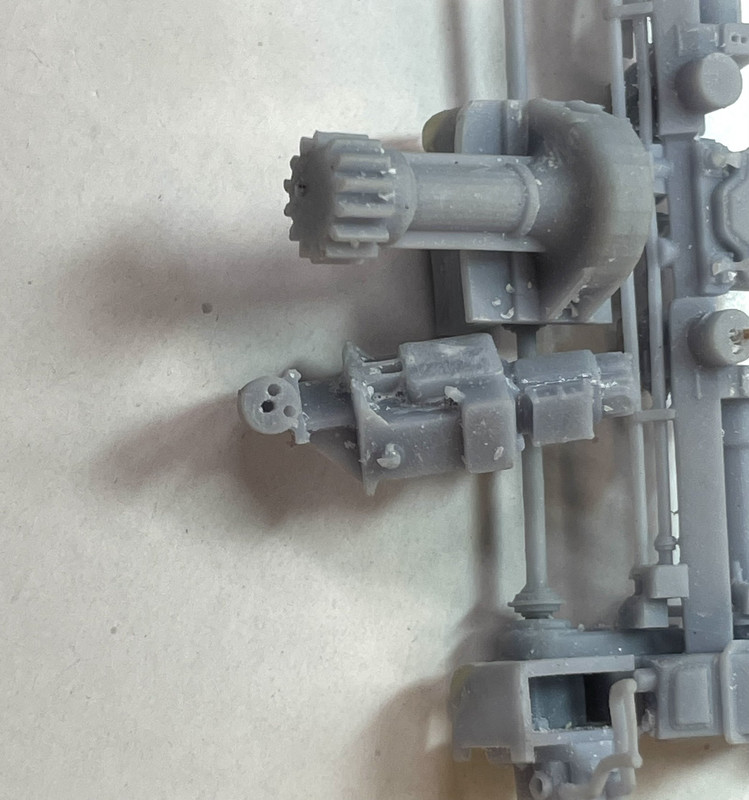
Fitted, but not glued. This will be glued after the gun trunnion cap is installed on that side.
I drew and printed the sight checker’s telescope. This station is only used during trainining exercises to evaluate the trainer and pointer proficiency. I made a lug on the mounting point that serves as a trunnion pin on that side. This solved a problem for me.
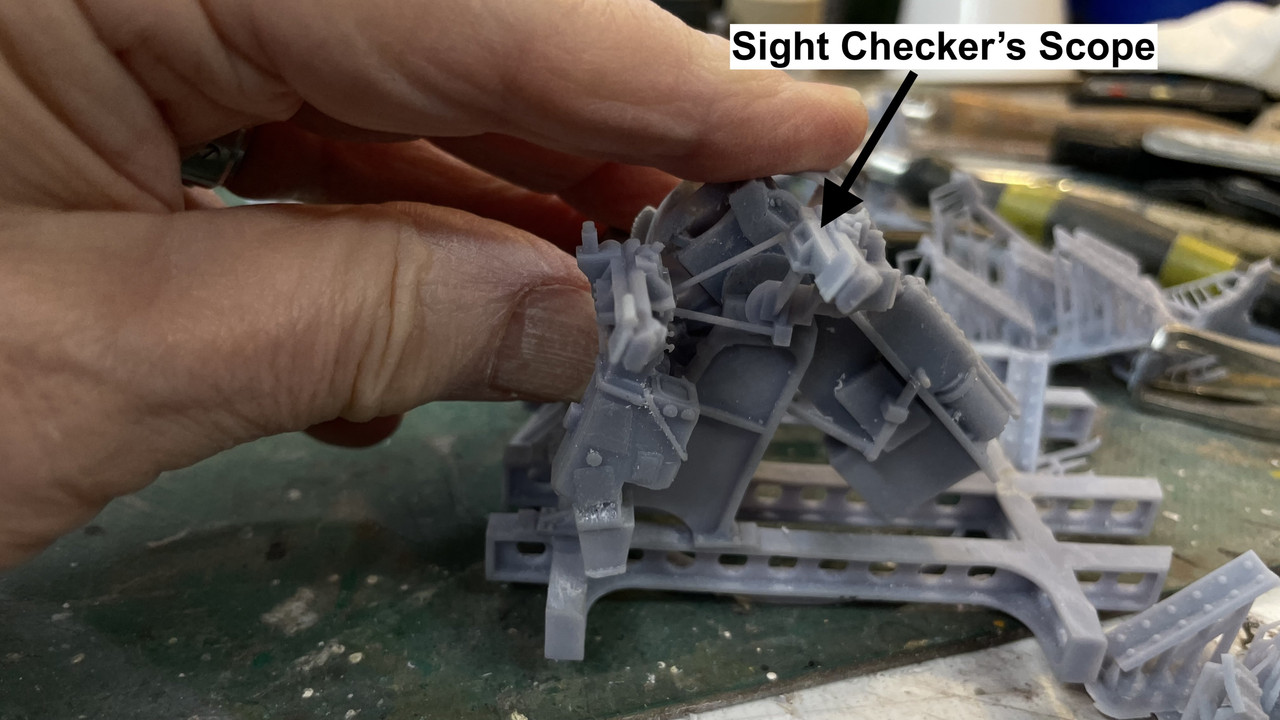
While there’s a just a couple of details left to do for the gun house, I’m starting on the upper handling room. I first tried to fit the entire wall structure as a single part, but as you can see, the setup on the printer was not ideal. Way too many supports for my liking.
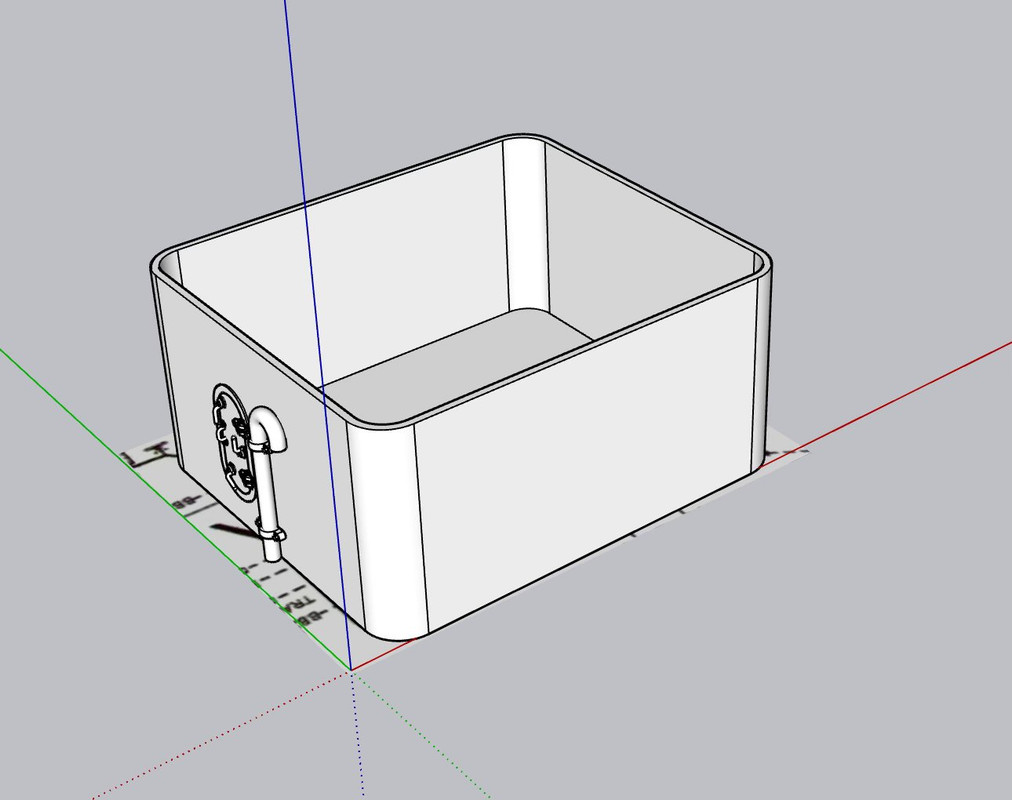
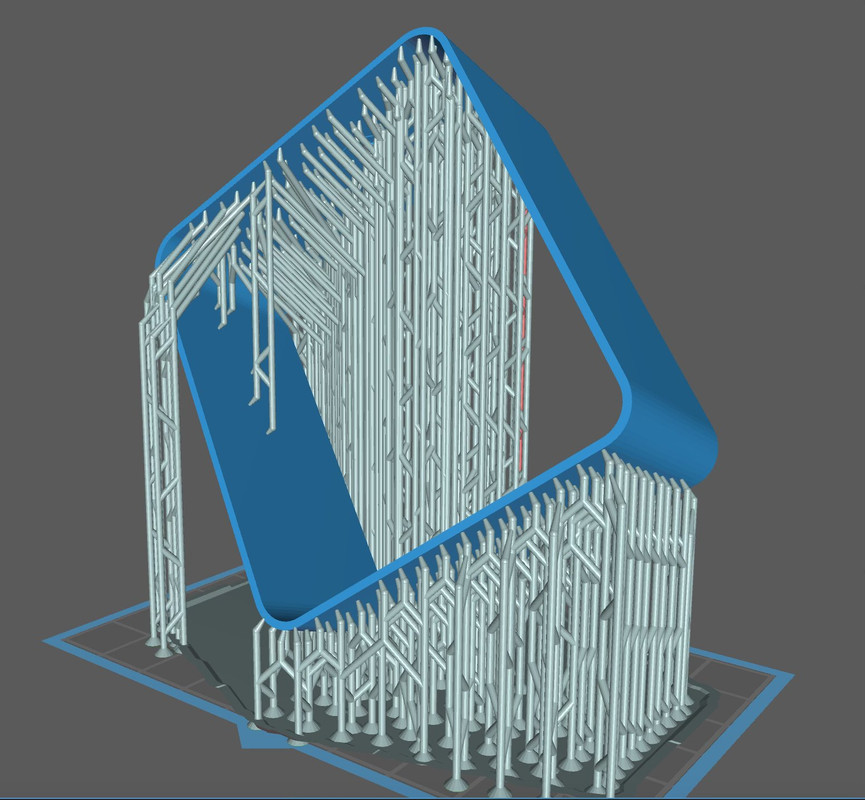
I have a friend with a bigger printer and talked to him about it, but I don’t have his printer model available on my slicer. So I went to plan B. Separte the four wall maintaining the nice curved corners. It’s those corners that dissuaded me from doing it out of styrene sheet. This permits me to leave on wall open if that’s the way I want to approch the cutaway. I did this same scheme when producing the little n-gauge buildings for the exhibition layout. They’re printing now and will finish in a couple of hours. Notice, no supports on cosmetic surfaces. Just the way I like it.
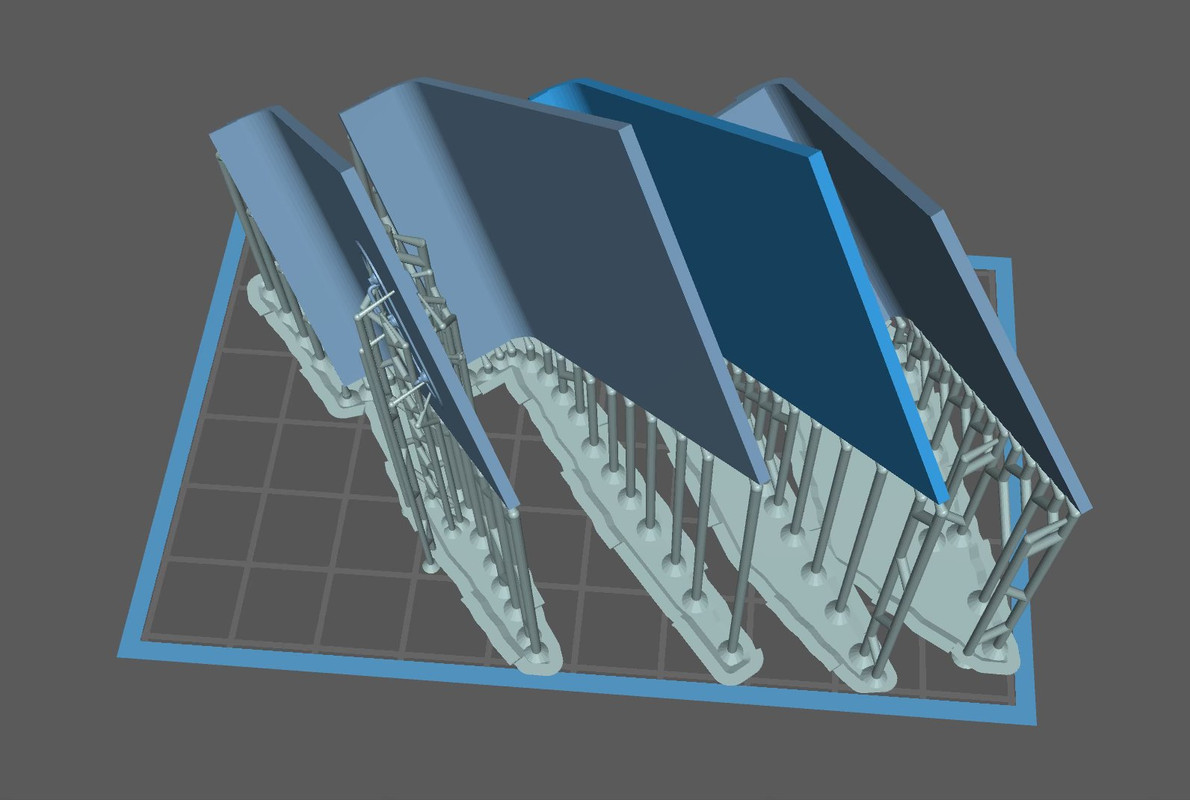
Happy to report that the print came out perfect, including the replacement bicycle seat assembly. It’s in the ultrasonice cleaner now, and I’ll finish them up tomorrow.
Wishing her a speedy recovery.
The parts continue to look amazing.
Thank you for the kind thoughts!
The wall print was very good. I broke some of the door dog levers, but that’s expected. They’re very delicate and I will replace with wire. The walls fit together as designed.
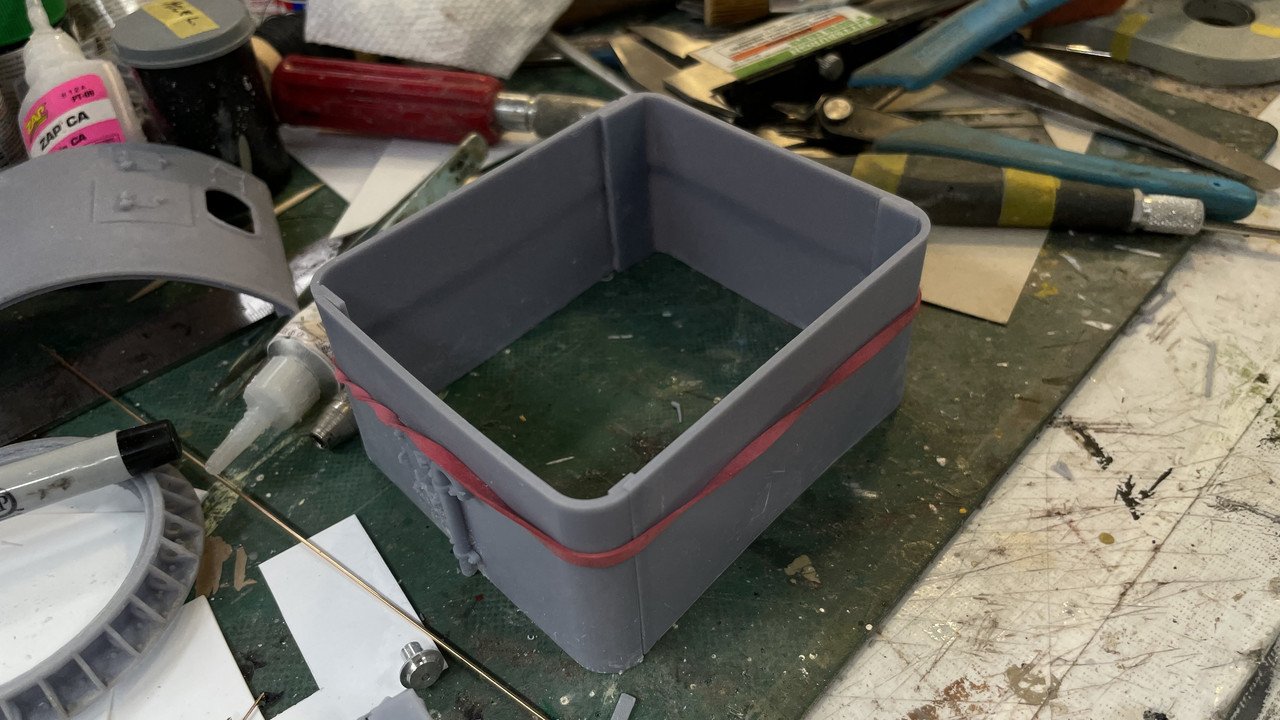
I put together a punch list for the upper works and it has 19 items on it. So there’s still a lot of work to be done here before turning my attention to the lower decks and main magazine. I almost have all the reference photos I need to finish this. I have just a couple more requrests for Ryan concerning the communications gear on the gun house rear wall, and the geometry of the cartridge chutes.
The sight setter’s seat came out better than expected. The support post is delicate, but the new 3.1 second printer settings are producing small details that have some strength. I post-cured these last two batches BEFORE cutting off the supports to impart more strength to withstand the support removal. It worked well.
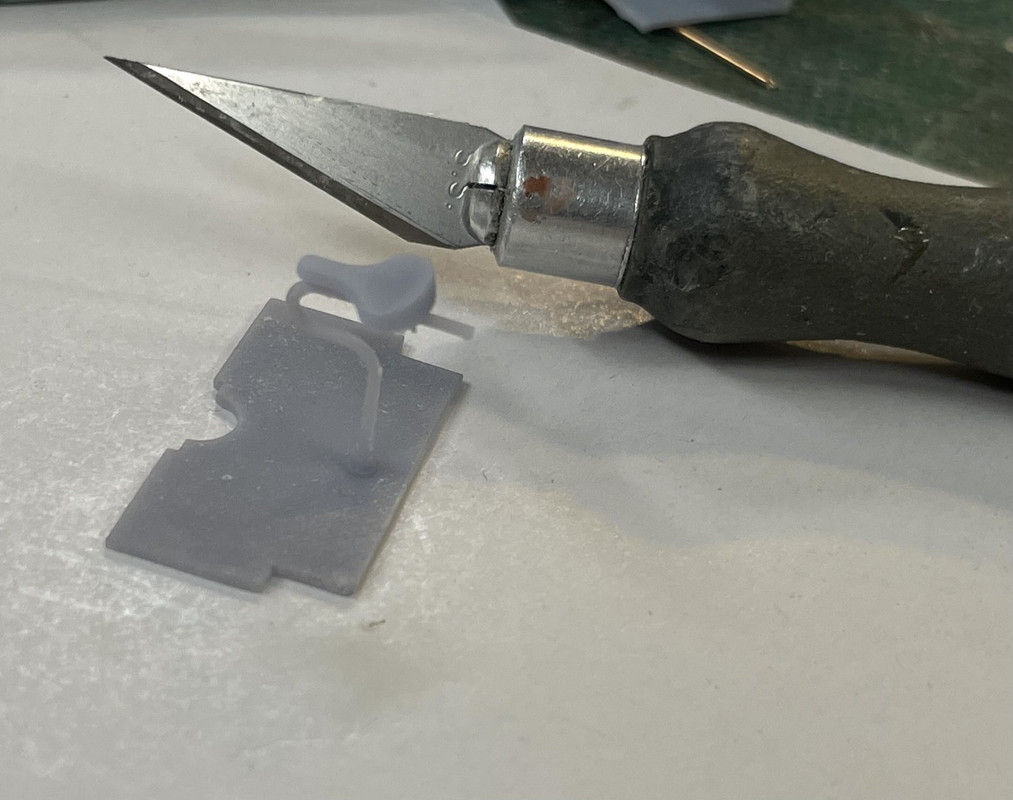
This little bit of floor has to key into the flanking gun mounts. I needed to find out if I could install it after the sighting system part was installed. Luckily, it could be.
This was the test.
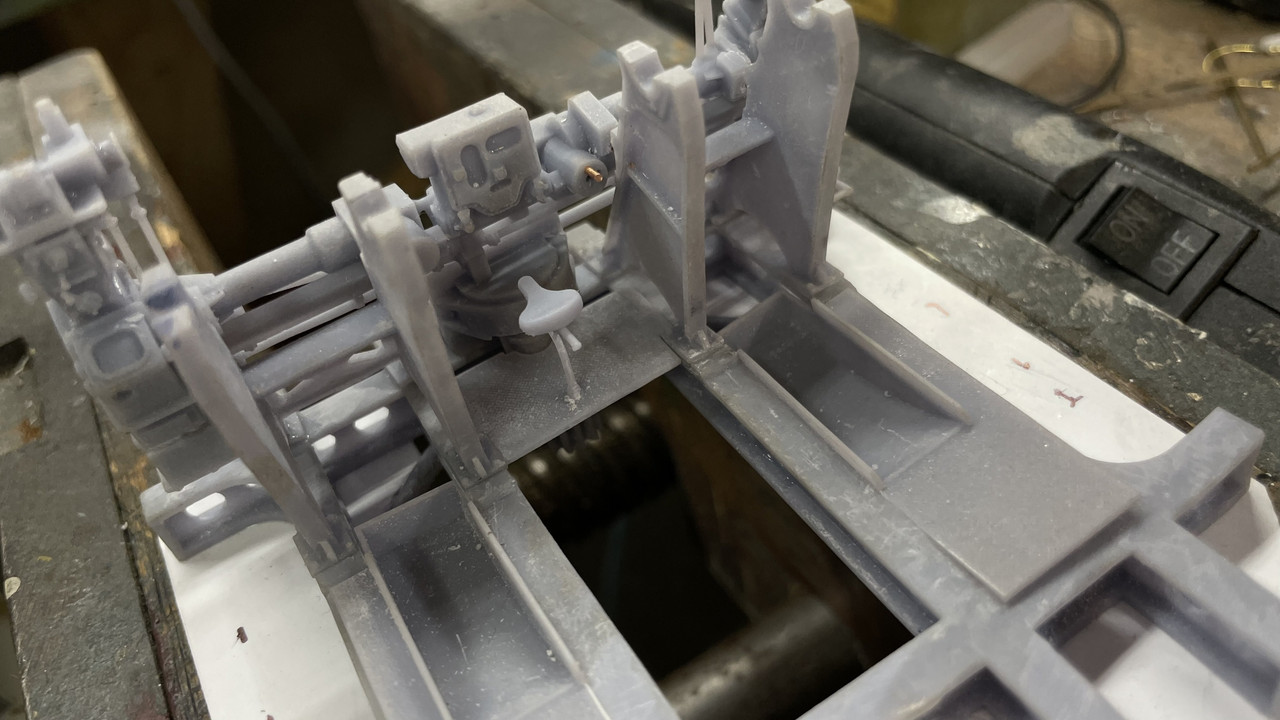
I now had another decision facing me. Do I paint the sight system before installation or after. I put it together now. It required a lot of pushing and shoving to get it all aligned during the tests, and I even broke one of the cross-rods. This led me to believe that I would really mess up the paint job in the process. I bit the bullet and permanently glued it in now and will wrestle with the painting going forward. What I can’t reach with paint won’t be visible anyway—or so I’m assuming.
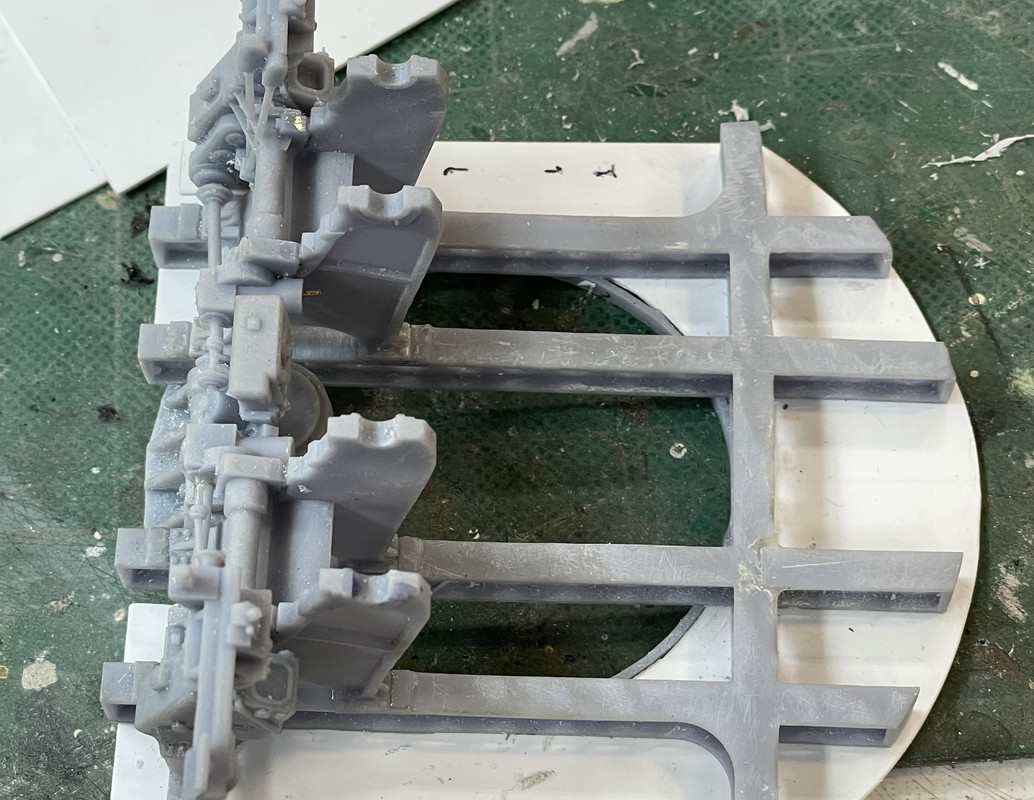
For some reason—probably some warpage—the trainer’s regulator console didn’t sit down on the frame. Rather than continue to force it, I made a shim. Again, no one will notice this when painted and enclosed in the gun shield.

Right now I’m about designing the cartridge chutes. I have good orthographic line drawings, but they don’t show the contours. I don’t believe these sheet metal contrivances are rectangular in cross-section. I’ll do the best I can, and then, after New Years ask Ryan for some pictures of its true shape.
This is that punch list to which I referred:

Everyone have a safe and happy New Year and I’ll see all y’all in 2024!
Outstanding work. I envy your talent! All the best to your wife for a complete and speedy recovery.
Thank you for all your kind words!
